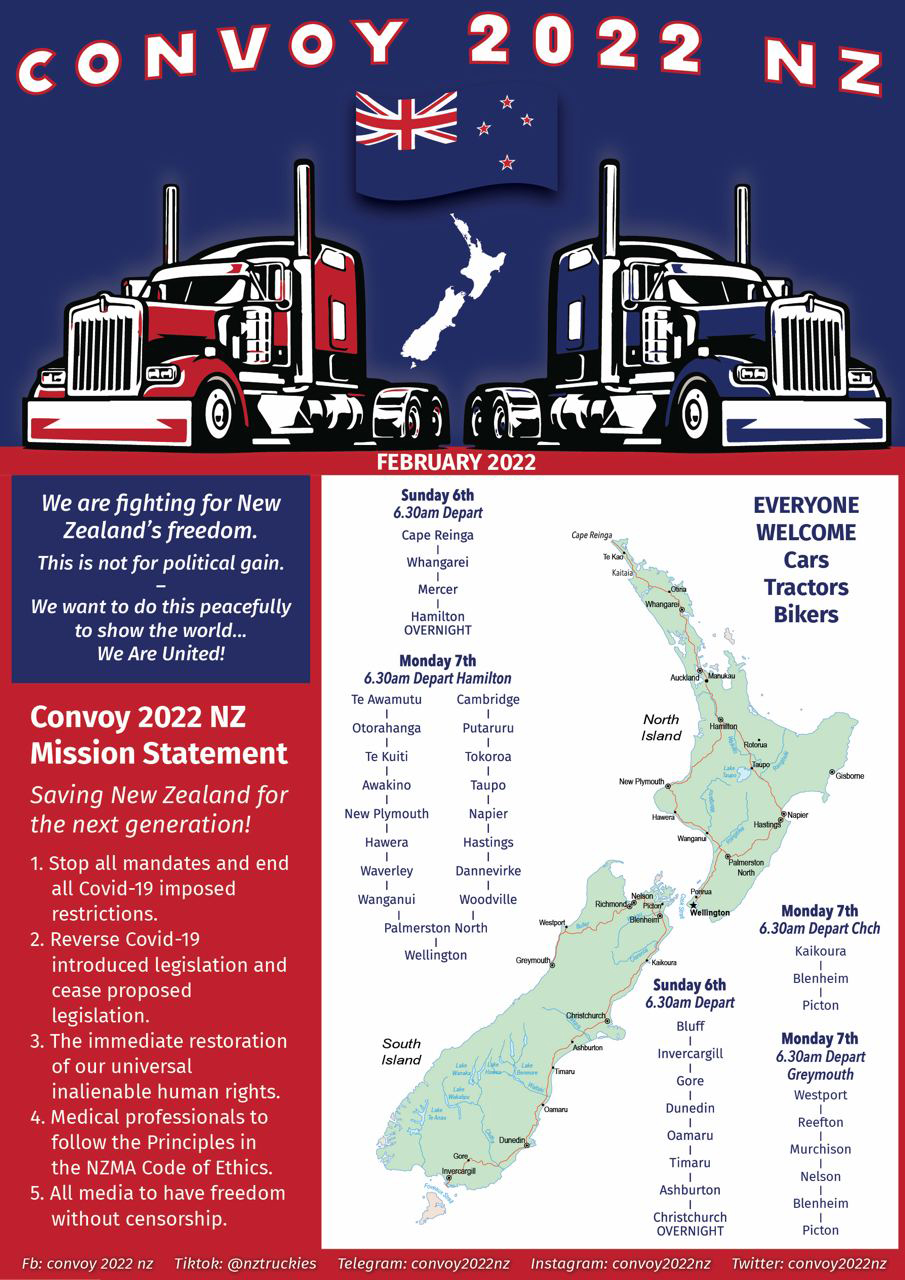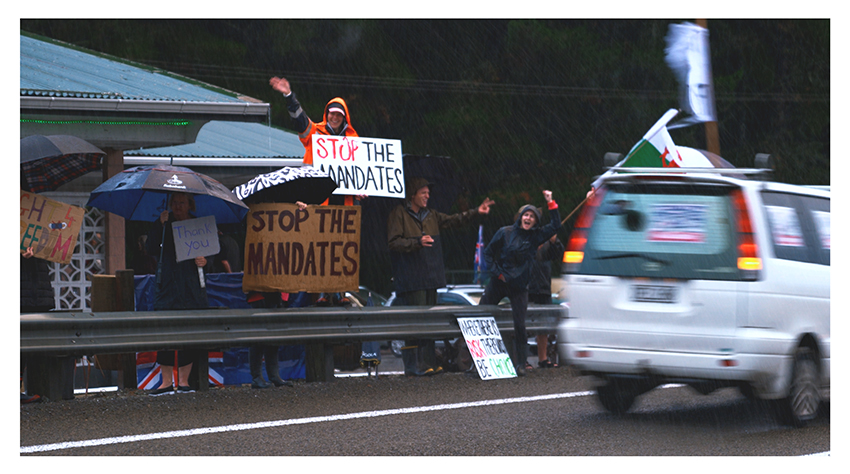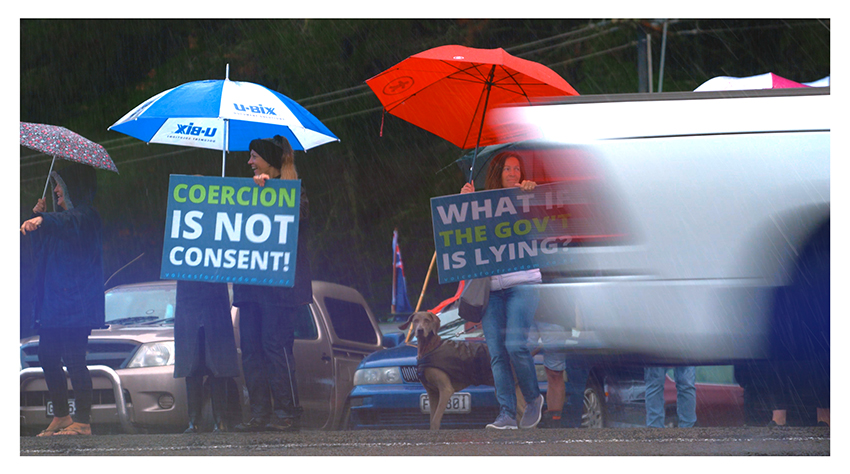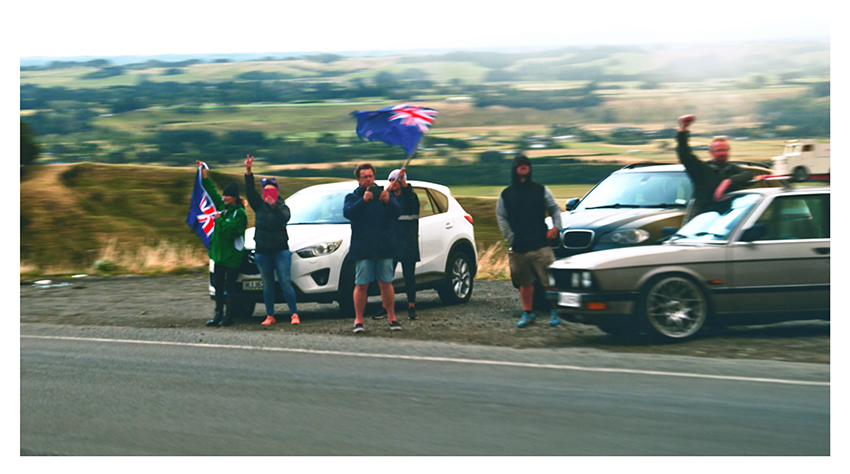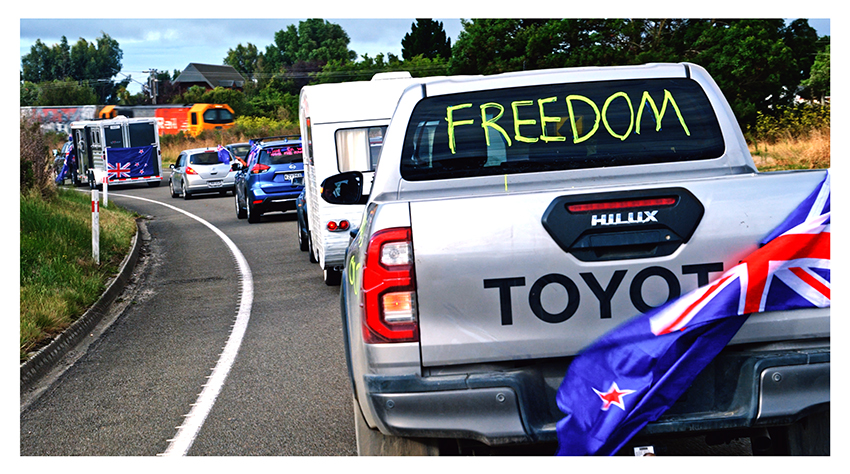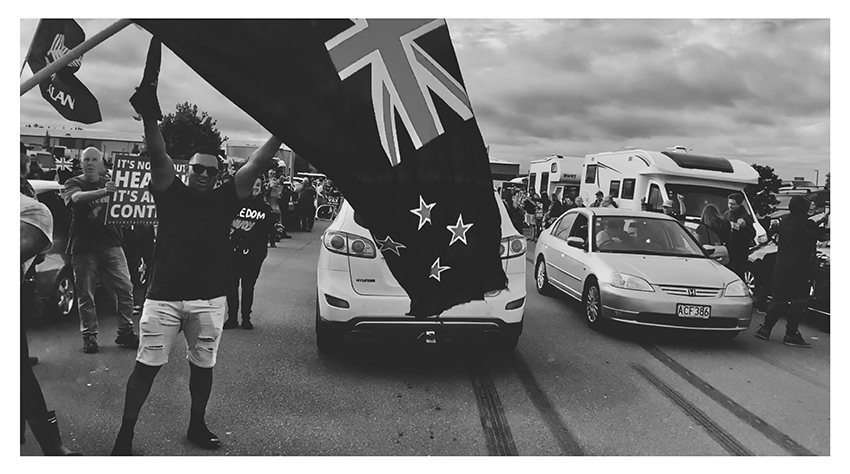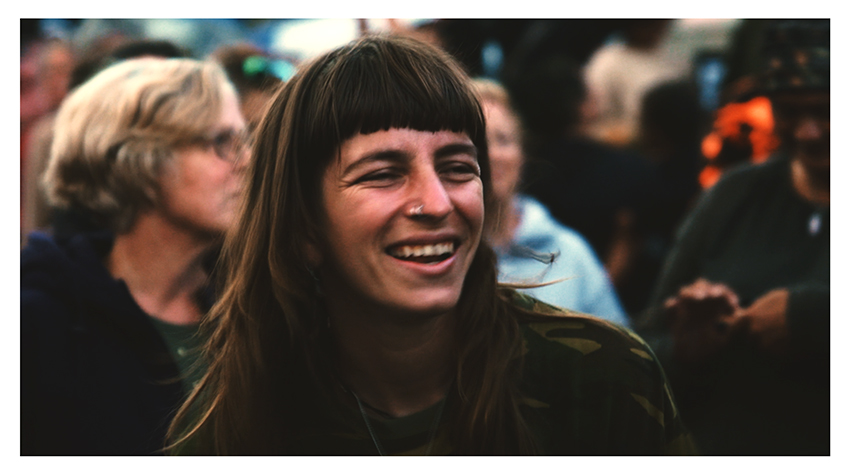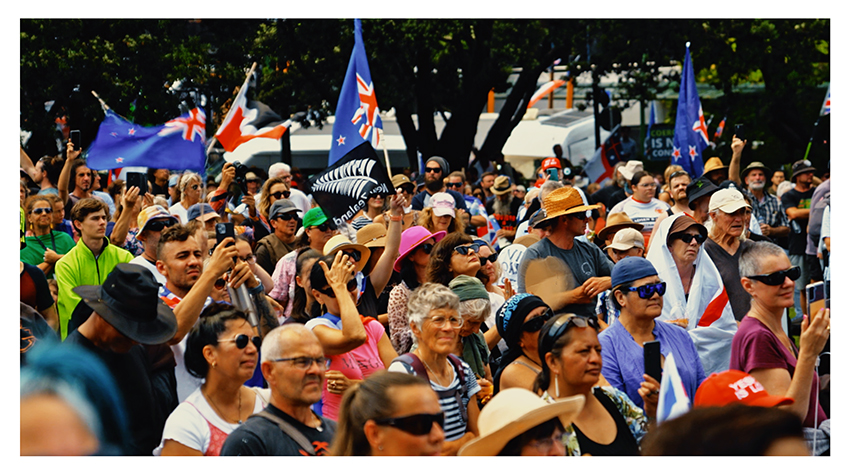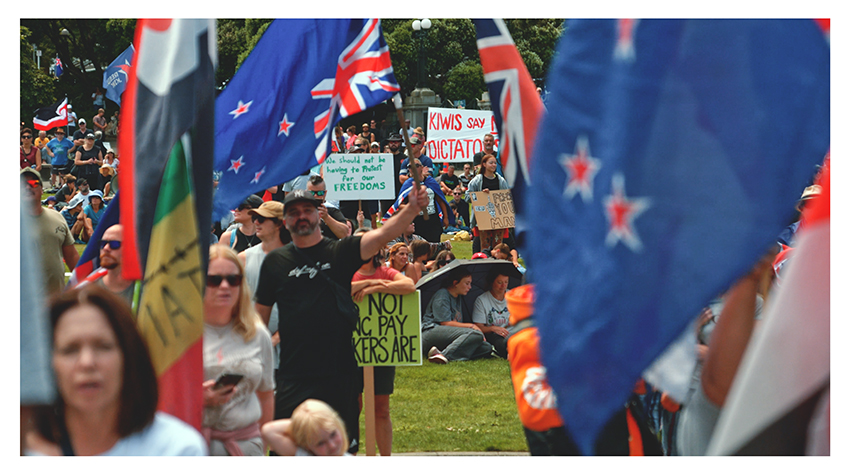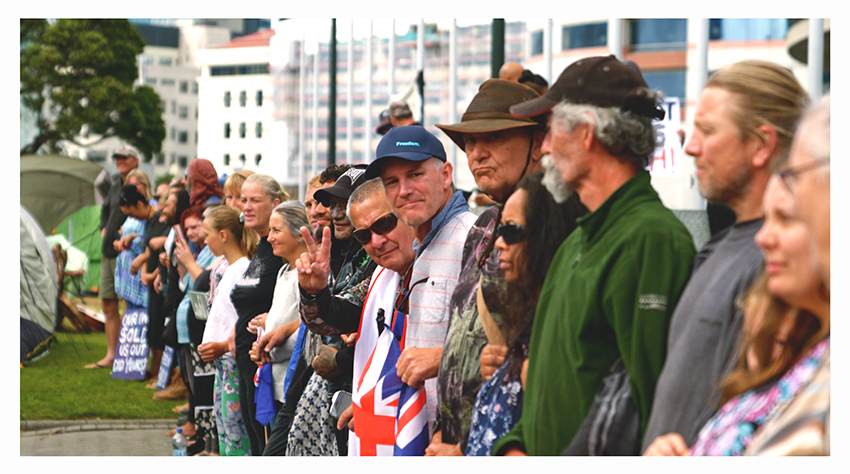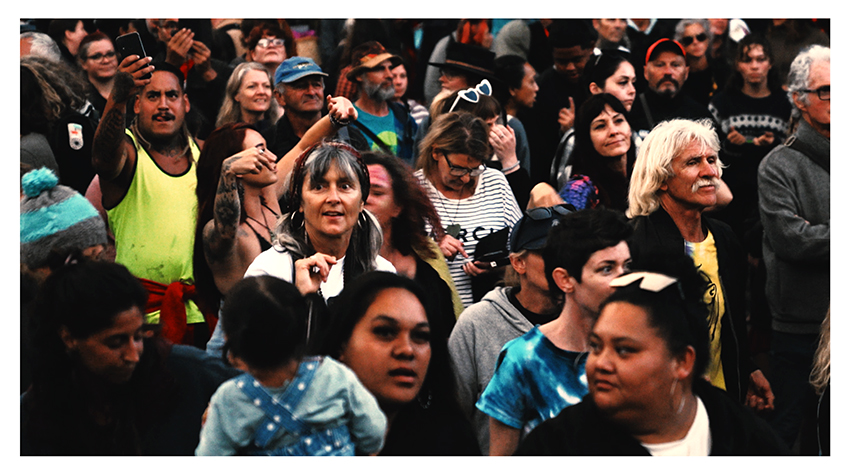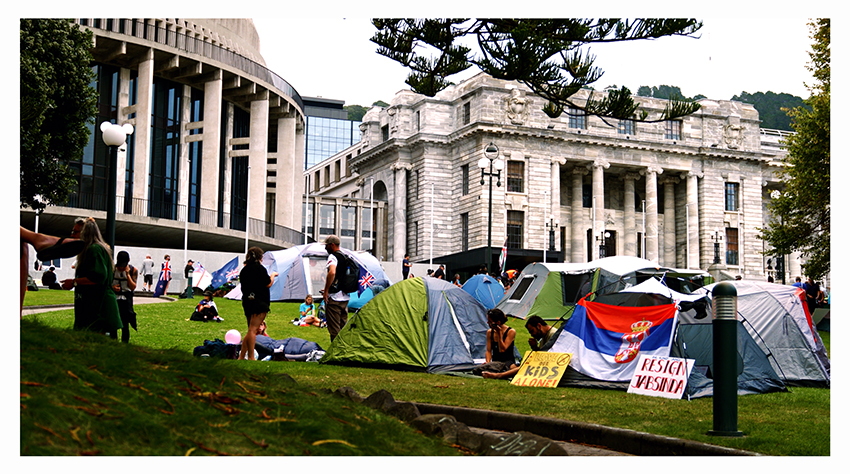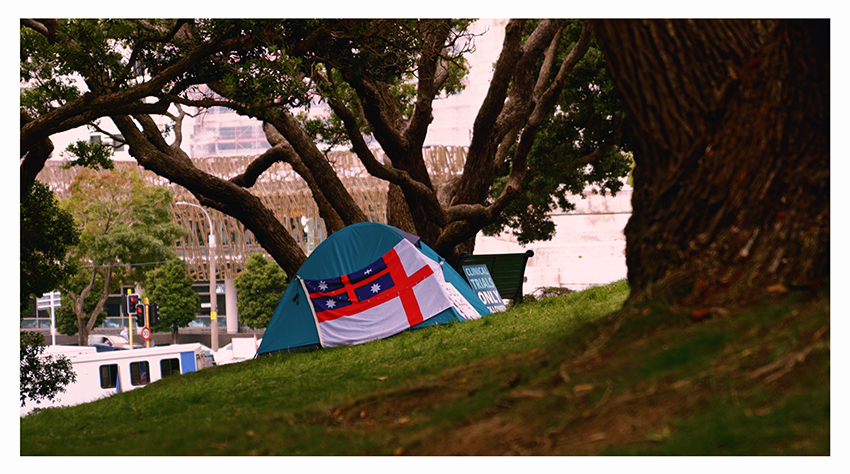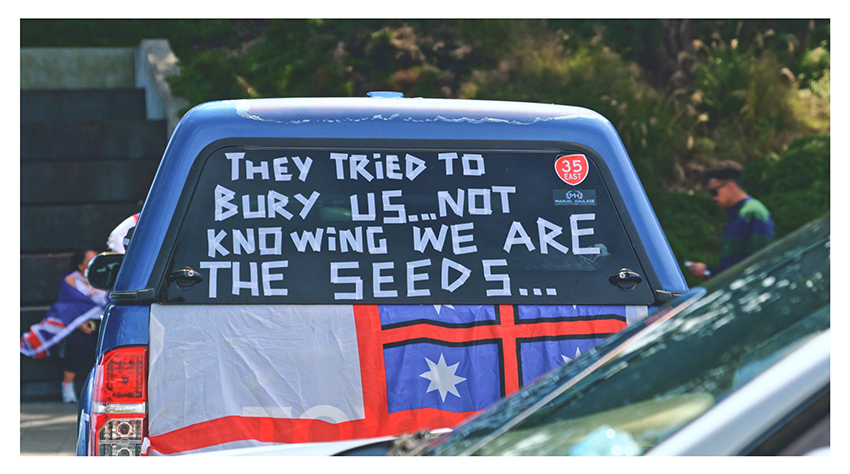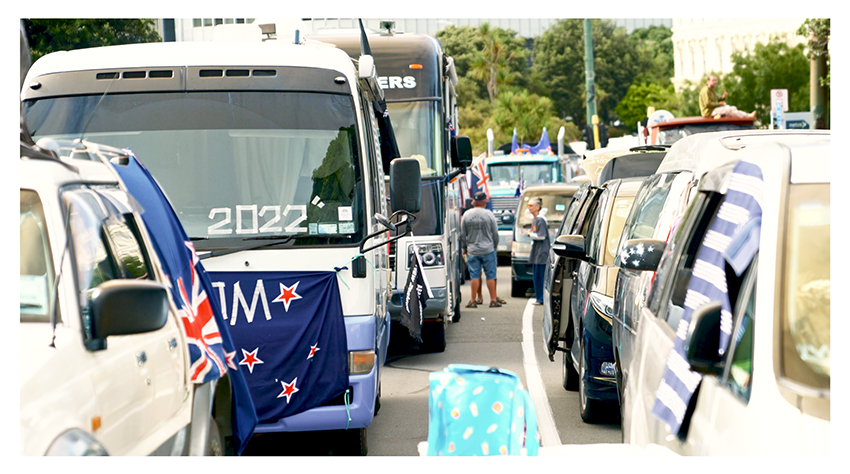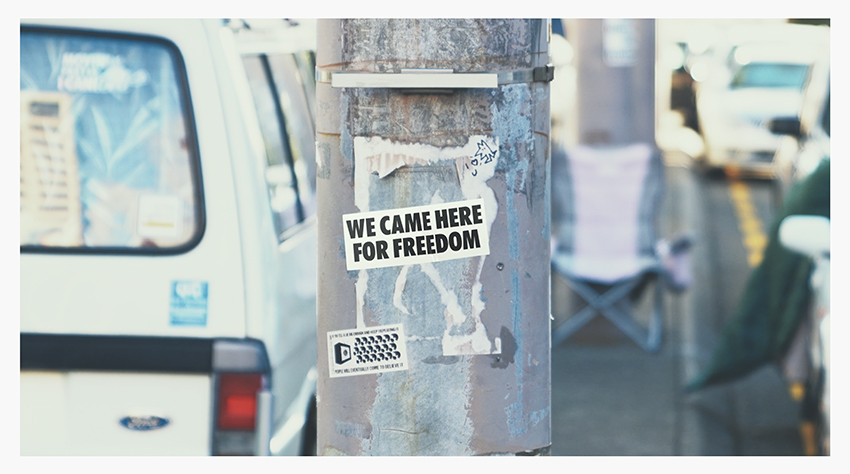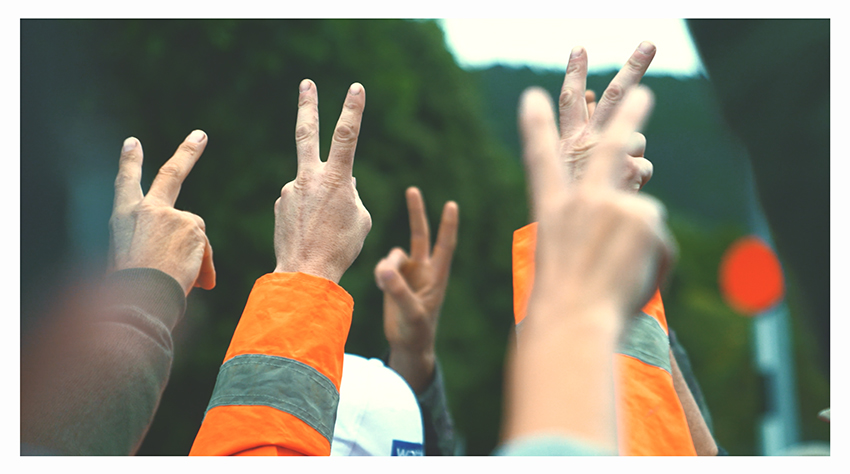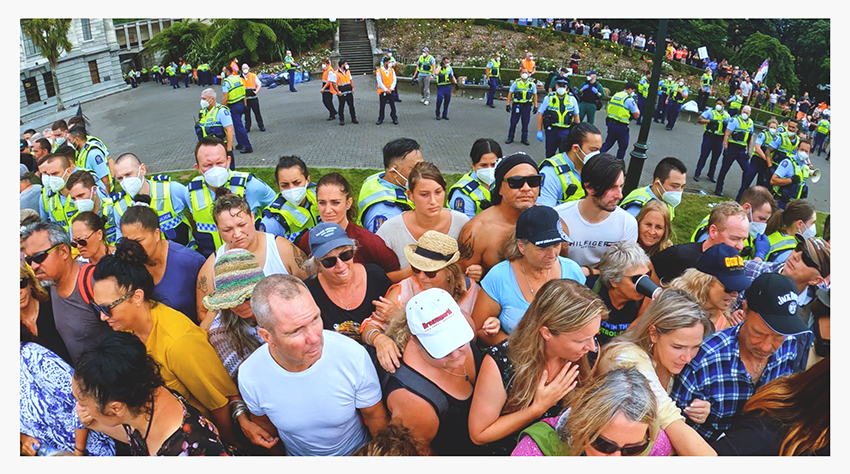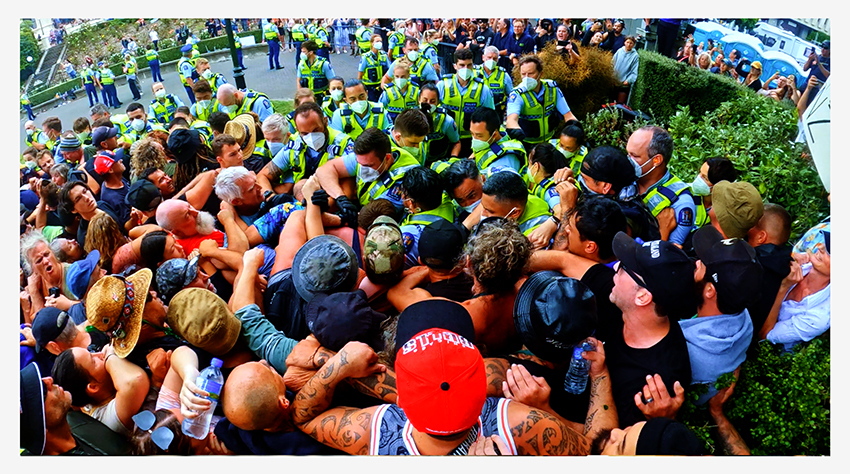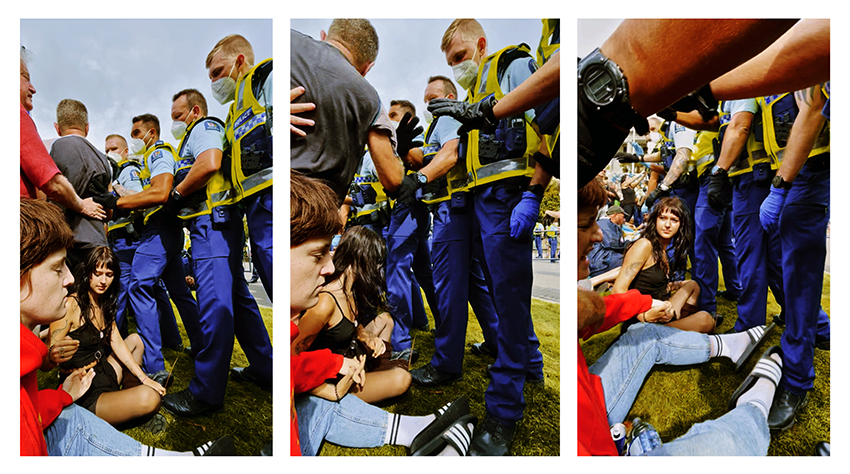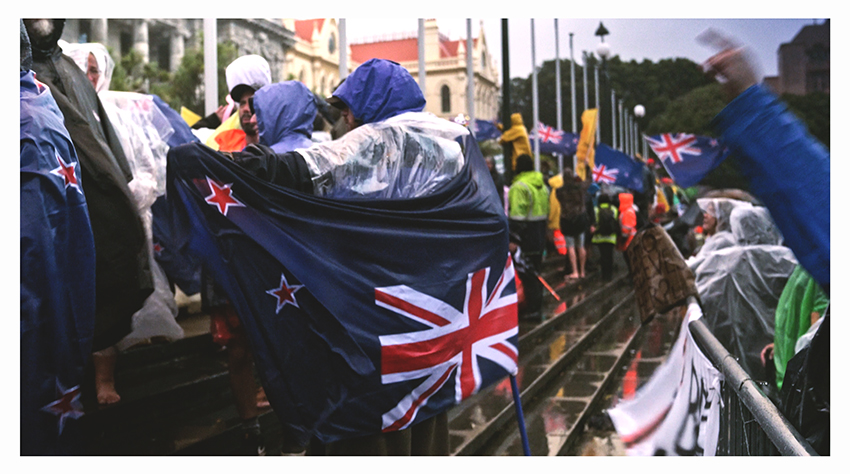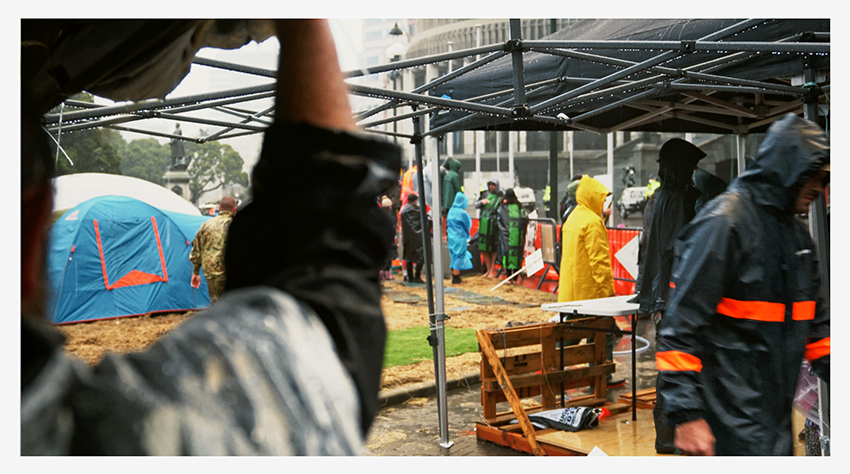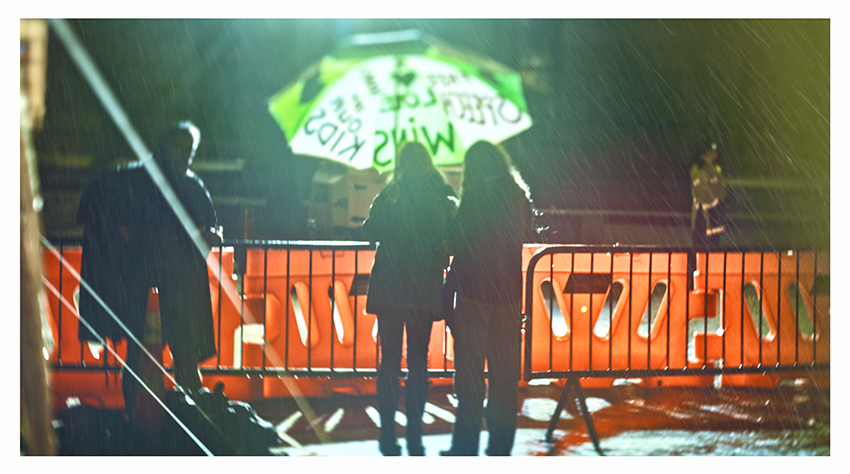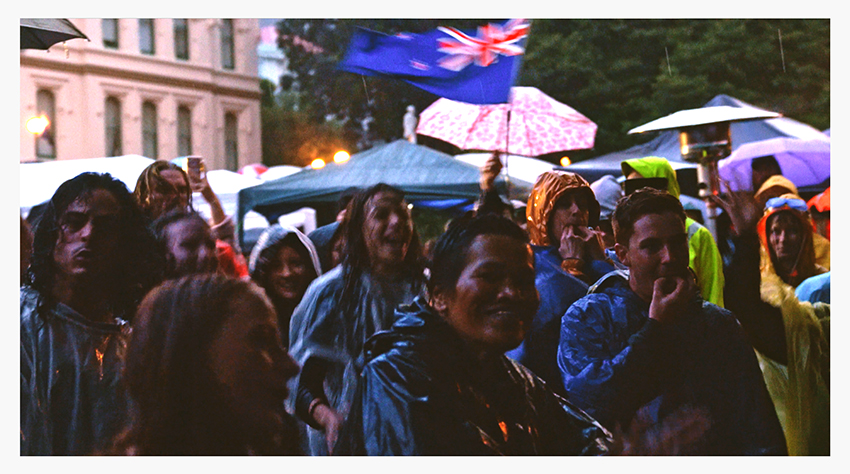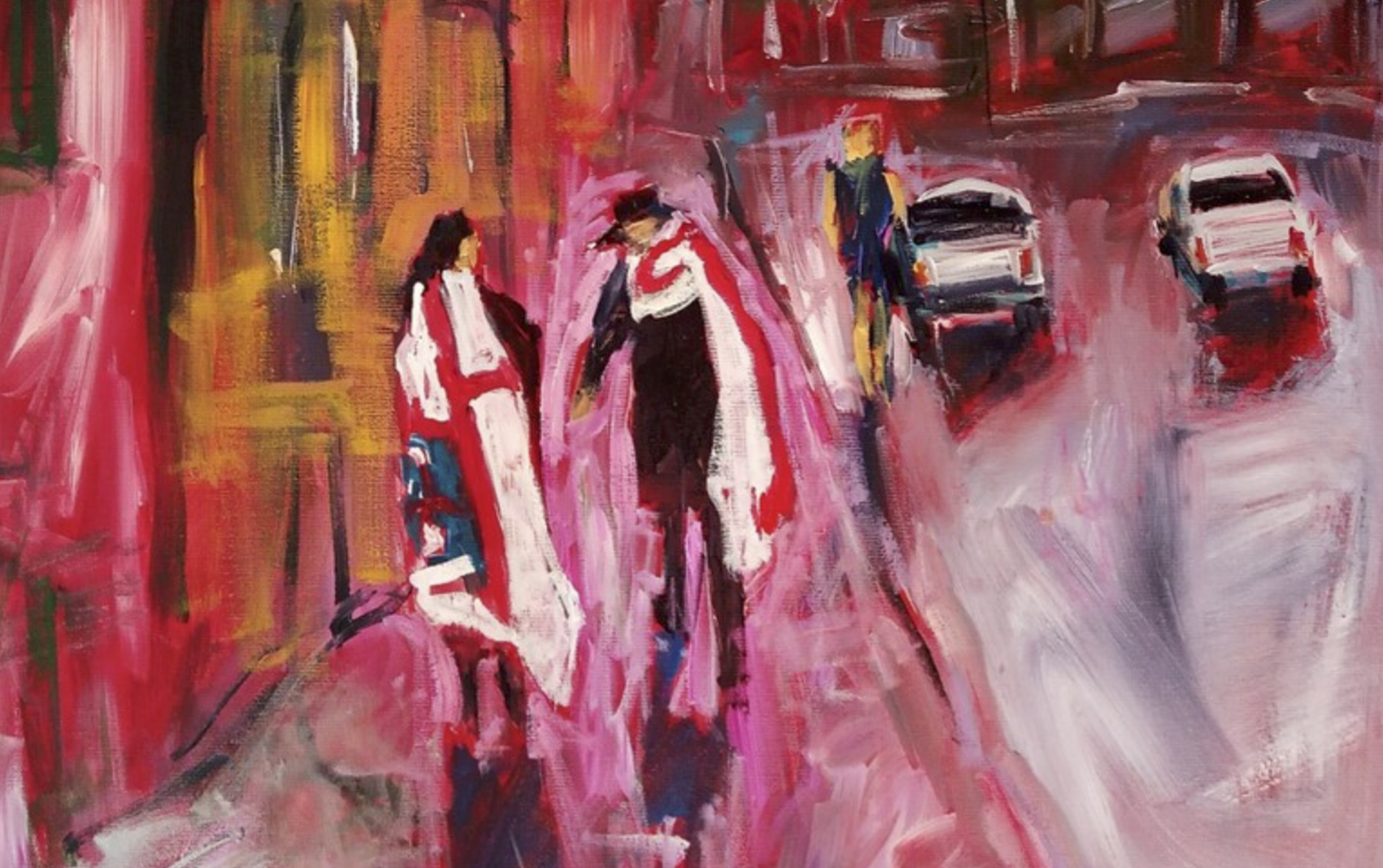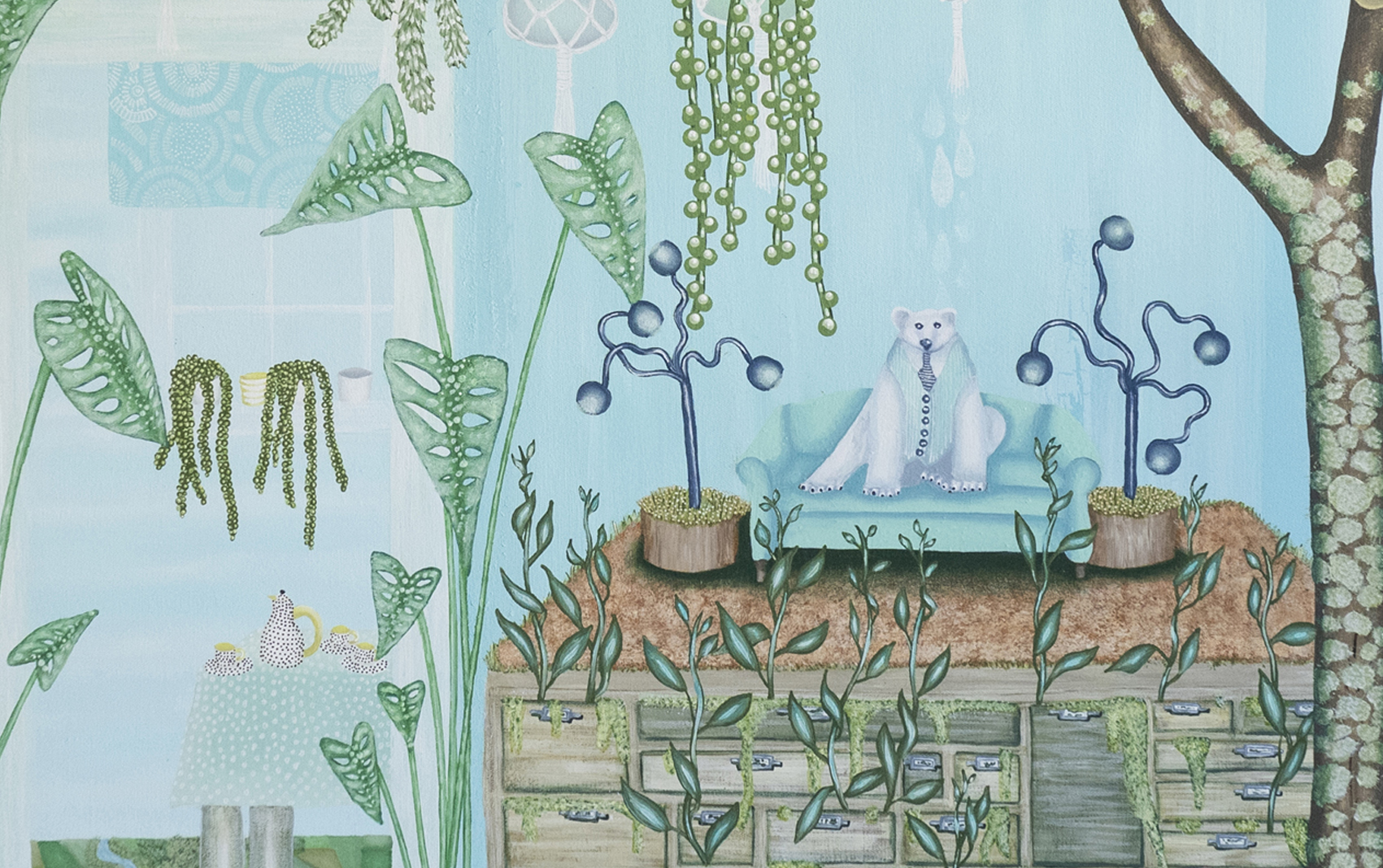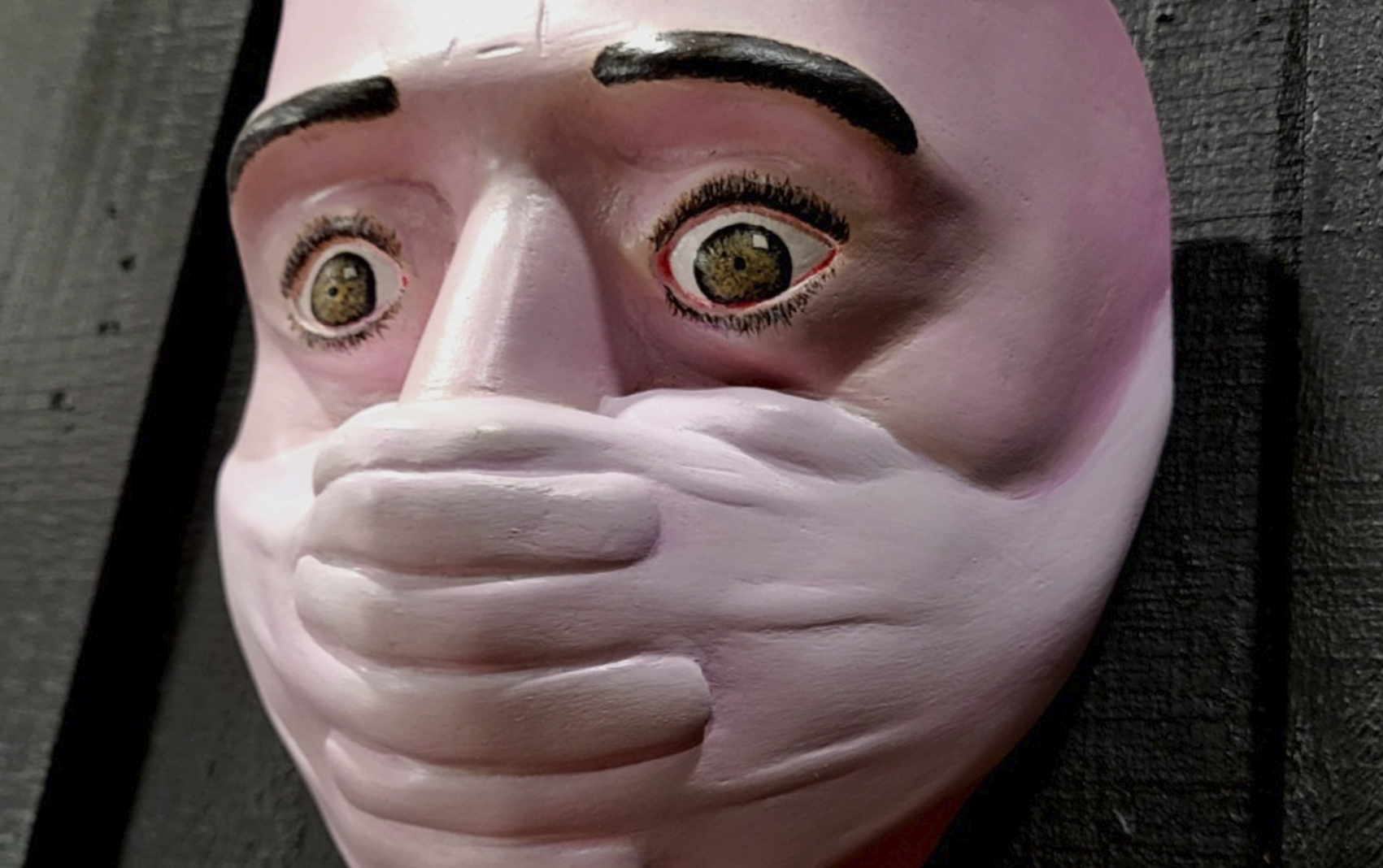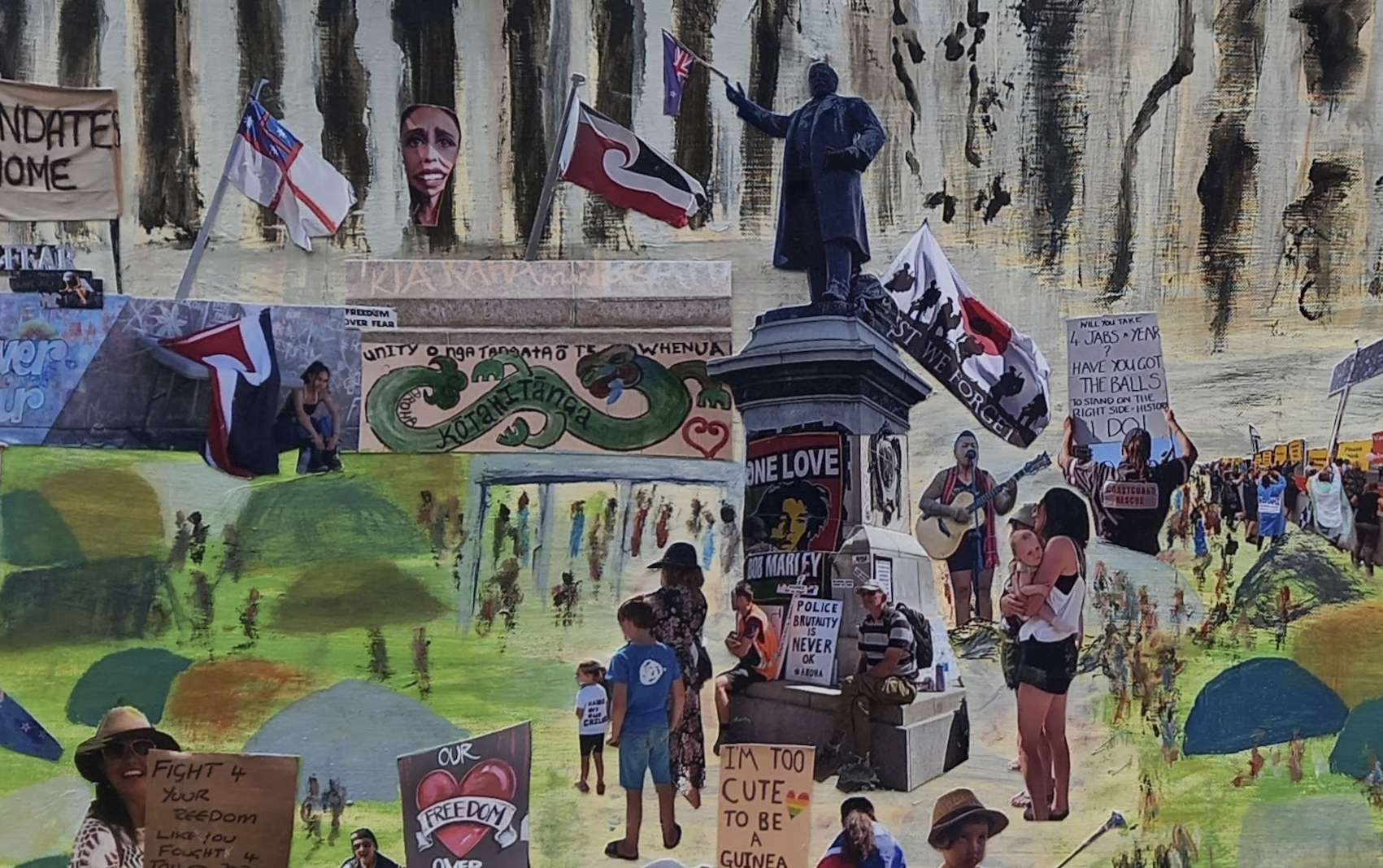What is democracy if your own
representatives won’t speak to you?
Watch the trailer
A story about a nation relearning the meaning of Freedom of Speech and Democracy.
In 2020-22, the New Zealand government enacted emergency laws, mandates and a medical passport system that caused thousands of New Zealanders to lose jobs, businesses, homes and health. Furthermore, those people were locked out of New Zealand society, unable to go to funerals or weddings, participate in sport, visit loved ones in rest homes or even to visit cafes and hairdressers.
But when New Zealanders who had suffered under the measures stood up to exercise their democratic rights of protest and freedom of expression, instead of trying to calm the tensions, the government ignored and demonised those who protested as a “river of filth”. And the media censored them and labelled them as white-supremacists and far-right extremists.
In the end, the divide became so large that the biggest protest movement in New Zealand’s history became inevitable, leading to the Freedom Convoy and Freedom Village occupation on the lawns and streets around parliament in February 2022. And as it happened, award-winning documentary filmmaker, Alistair Harding followed along, living amongst the protesters, filming the events and recording the stories of the people who participated.
The result is We Came Here for Freedom – a documentary film in two parts giving voice to the thousands of New Zealanders who were ignored and mis-represented by their own government and media.
It all started with a convoy.
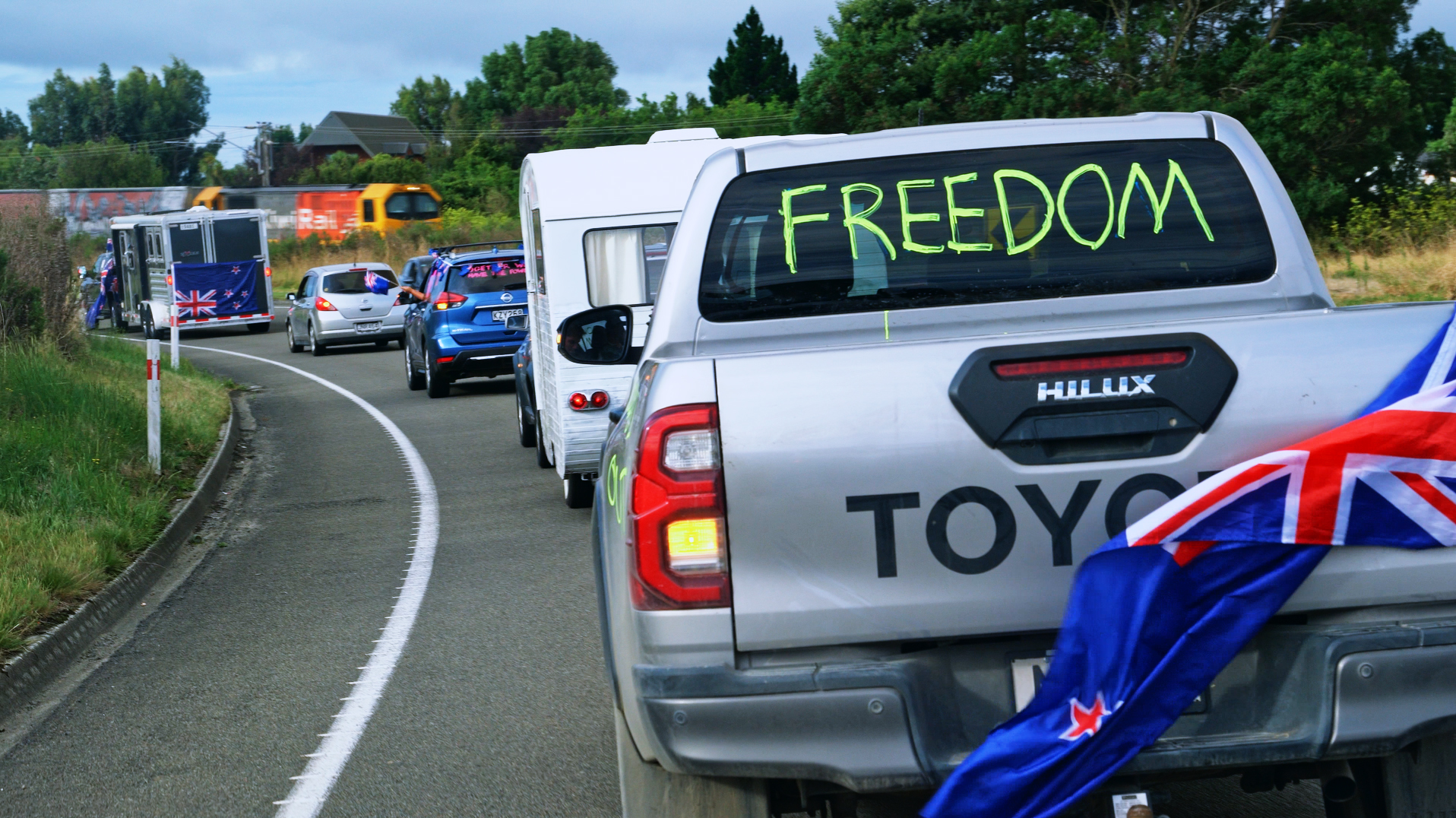
The people’s story
On February 6, 2022, an unprecedented event began taking place in New Zealand. Inspired by the Canadian truckers’ Freedom Convoy, New Zealanders from all walks of life began an historic convoy of their own. Starting from Cape Reinga at the top of the North Island, and from Bluff at the bottom of the South Island, the convoy headed to Wellington, gathering along the way tens of thousands of New Zealanders across the length of the country.
It was the biggest outpouring of spontaneous community spirit ever seen in New Zealand’s history, as suddenly the great myth that those who questioned the government’s actions during the covid era were a “fringe minority”. Instead, thousands of cars formed a line of flashing hazard lights that literally went the length of the country past tens of thousands of cheering New Zealanders.
It was a spectacular display of people power.
The effect was undeniable. The people had spoken, and by the time the Freedom Convoy reached Wellington, the response from all 120 members of parliament – including the opposition members – was to quickly band together and agree that they would not speak to any of the protesters who gathered on the parliament lawns. The very people they represented.
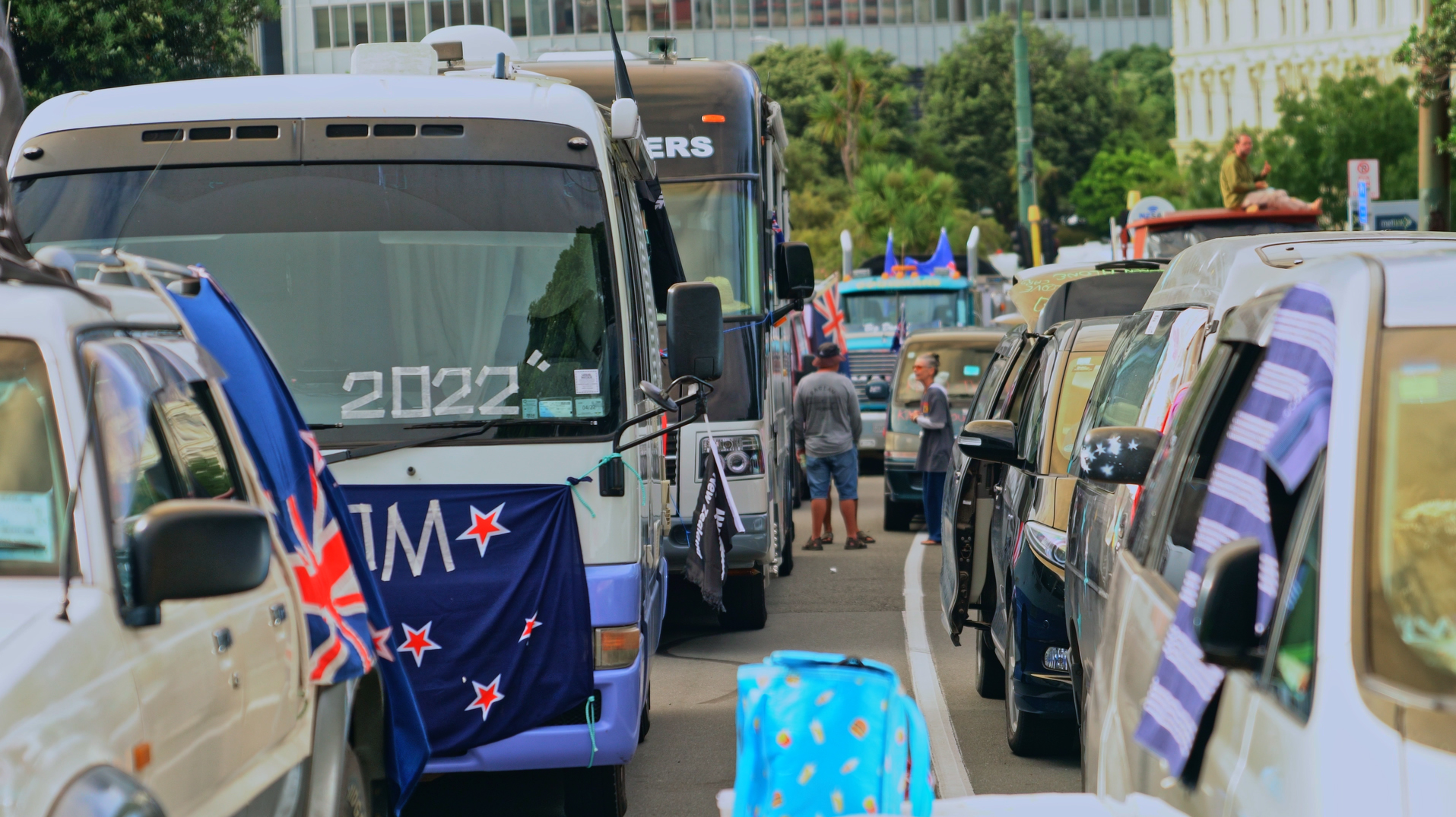
And so the impasse began.
A village formed. And as the government and its opposition parties refused to talk to the people, the people refused to move.
And suddenly, the question began to be asked: “If the members of parliament don’t want to speak with the people they represent – who DO they represent?”
Ignored and hurt
At the core of the issues that caused the Freedom Convoy and the Freedom Village, were the people hurt by the government policies surrounding medical mandates and restrictions on freedom. Among the people who gathered on the lawns and streets surrounding parliament were people who had lost jobs, businesses, livelihoods, and health.
Yet despite all that hurt, the government and media refused to acknowledge them, and instead began a campaign of vilification.
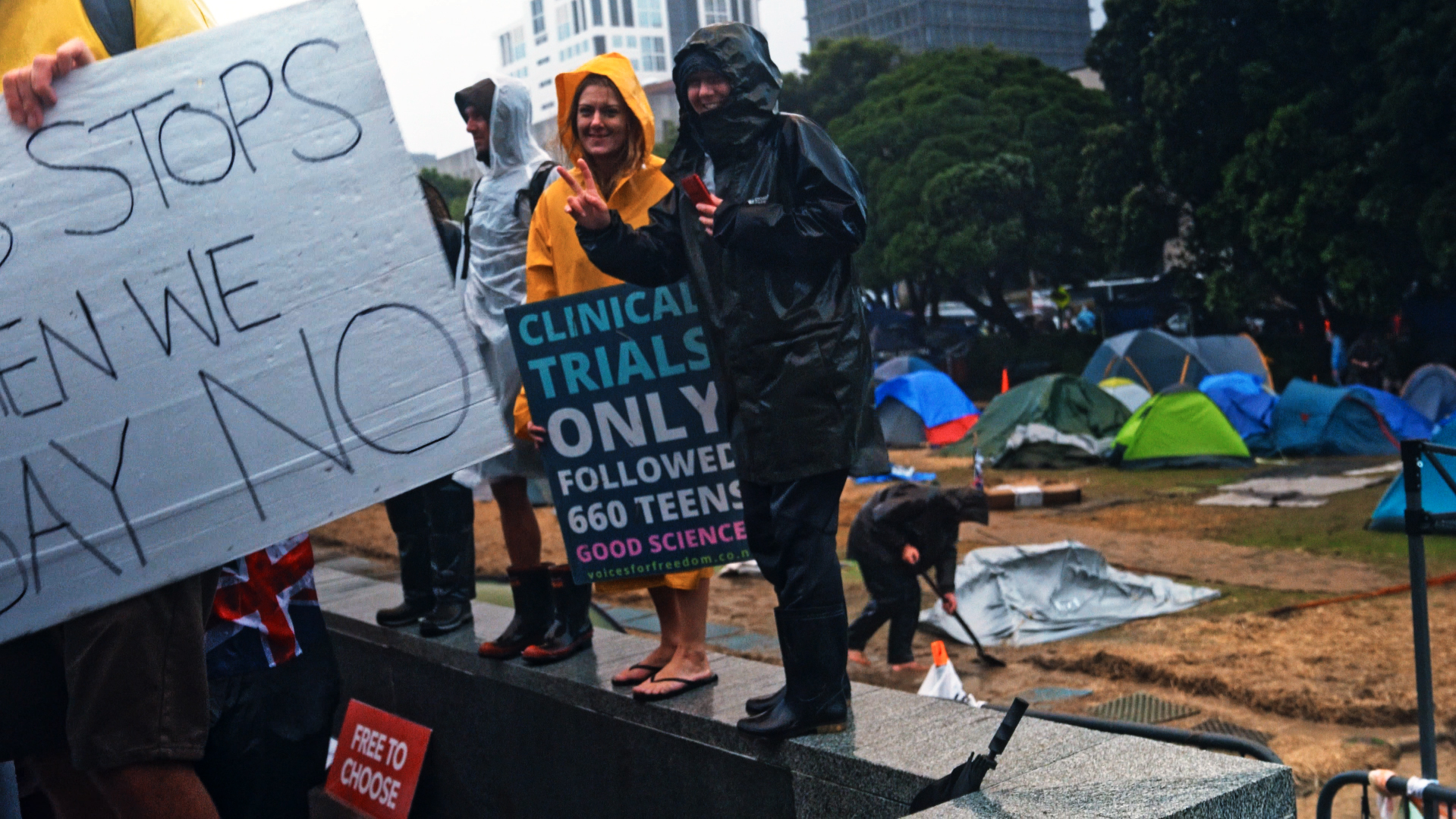
Chiefly among those was MP Michael Woods’ parliamentary speech, in which he referred to the protestors – the very people who he represented – as “a river of filth”. As a sign of how far democracy in New Zealand has fallen, it was a claim that was not protested by any of the MPs in parliament, including the opposition members.
Then, as if emboldened by such rhetoric, the media joined in, openly attacking and vilifying the protestors who had already lost so much.
We Came Here For Freedom is the story of the Wellington occupation from within. It is a story that most New Zealanders have simply not heard because both the New Zealand government and media refuse to acknowledge the stories of their own citizens.
We do not expect every New Zealander to agree with this film, but we do expect that every New Zealander should be given a voice, by right.
This is the story that the government and the media of New Zealand has fought to suppress.
It is the story that tells of the protestors at parliament in February 2022, not as “filth”, but as New Zealanders worthy of a voice.
Full film coming soon…
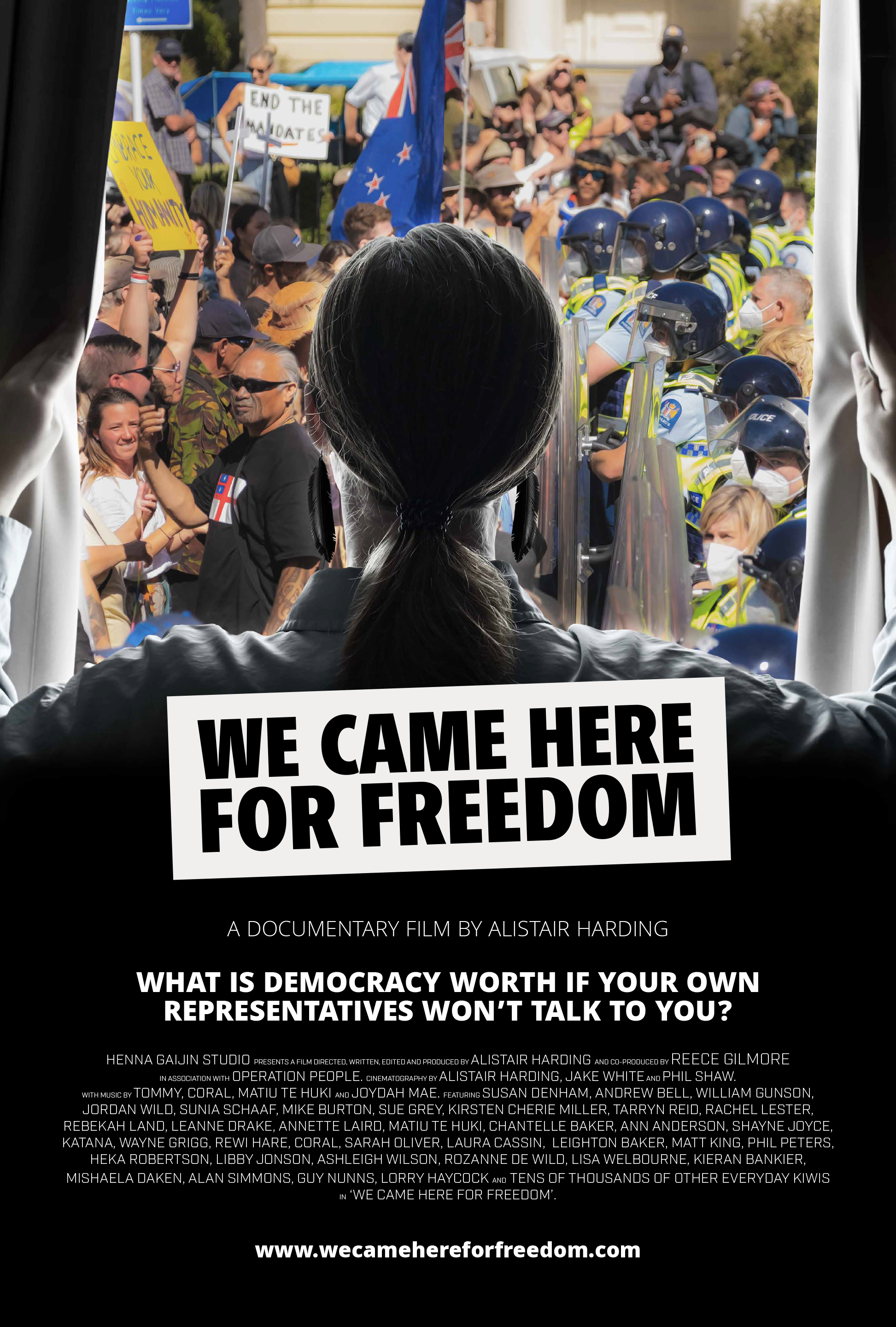
LEARN MORE | Voices, Memories, Music and Art inspired by the protests.
music
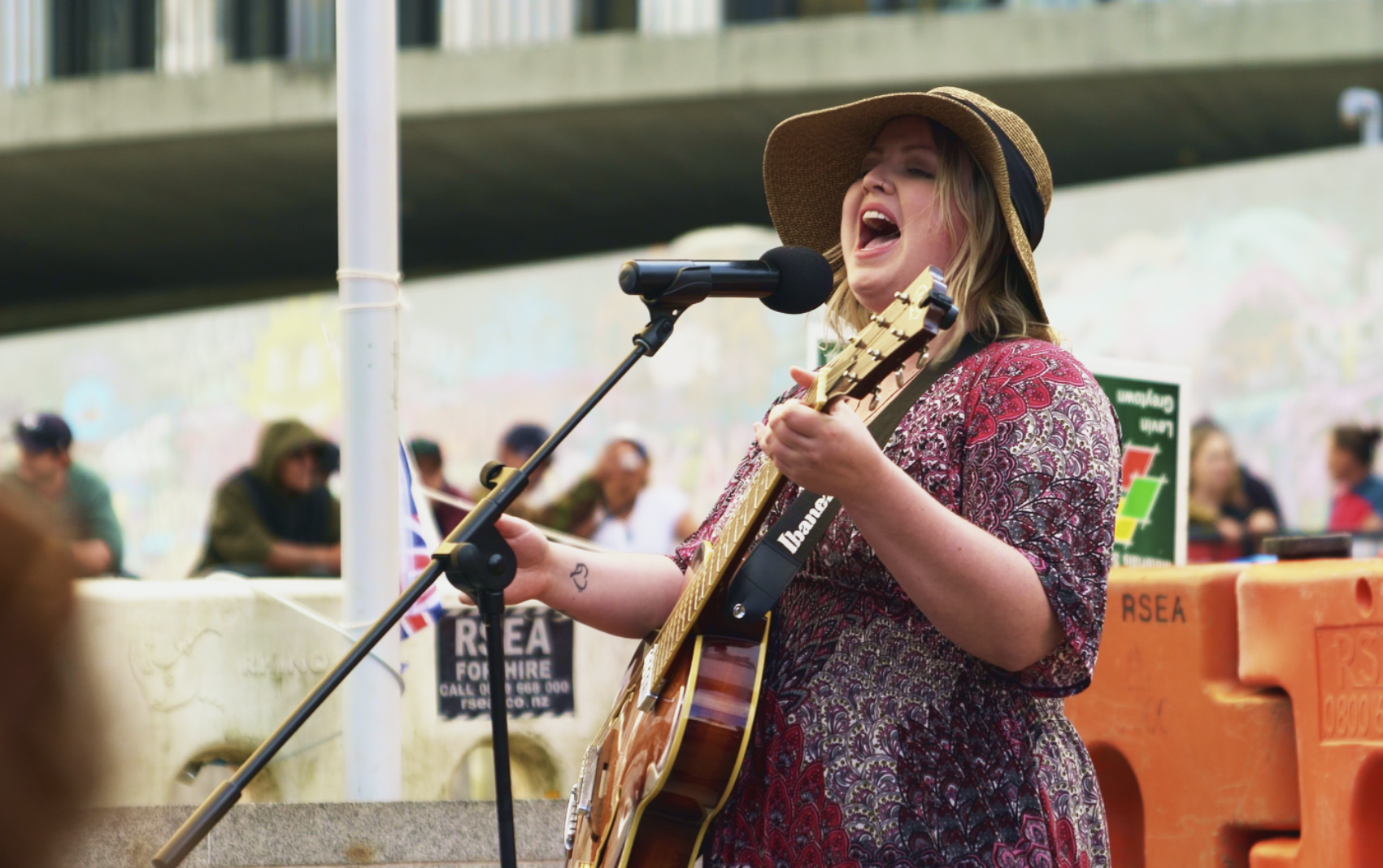
Thank you
Kiwi talent in abundance.
One of the most incredible things about the Wellington protest was the experience of walking around the Freedom Village, hearing all the different musicians that made the parliament lawns their home for those three weeks in February 2022.
The amount of talent on show was astounding. One of those musicians was Coral – who performs her song “Freedom” in Part 2 of We Came Here for Freedom. Another of her songs that has become synonymous with the Freedom movement, was “Thank you”, which we feature here.
Coral’s ancient voice delivers messages of freedom, hope, gratitude, and love channelled through her songs. After many years of performing around the country Coral has found her true calling of raining down light code and uniting the people with the healing power of music. “Our evolution is the revolution.”
writing
Our family day at the Wellington protest.
By Scott
Having been affected by the authoritarian and patently unjust vaccnation mandates, my family and I were excited to hear about the convoy heading to Wellington and walked up to our local motorway overbridge to cheer them on as they went past on Sunday 6th February. We stood with other Kiwis waving our national flag and holding up a sign that said “No Mandates”. We figured that over a quarter of the cars driving under us tooted and waved in support of our message. What we didn’t realise initially was this was not even the convoy. When the convoy arrived we really knew about it. Vehicles decorated in flags and banners cruised through in one almost continuous stream for over half an hour. We could not believe the numbers.
… Read more
Were you inspired by the Freedom Convoy or the parliament protests of February and created art from it? Or written your memories of it? We would love to feature your work here. Contact us today with the email link at the bottom of this page.
voices
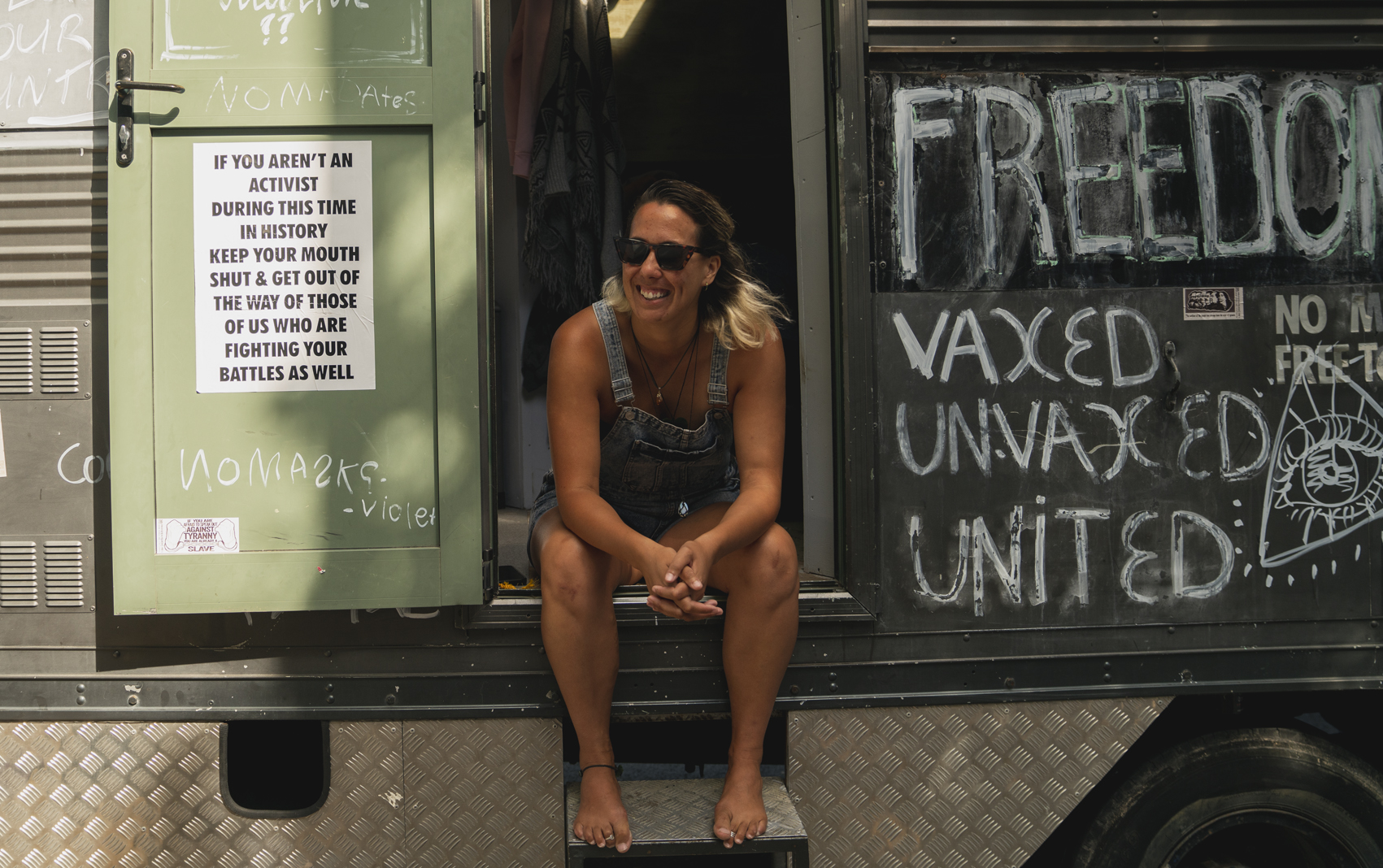
My reasons for going on the convoy
voices
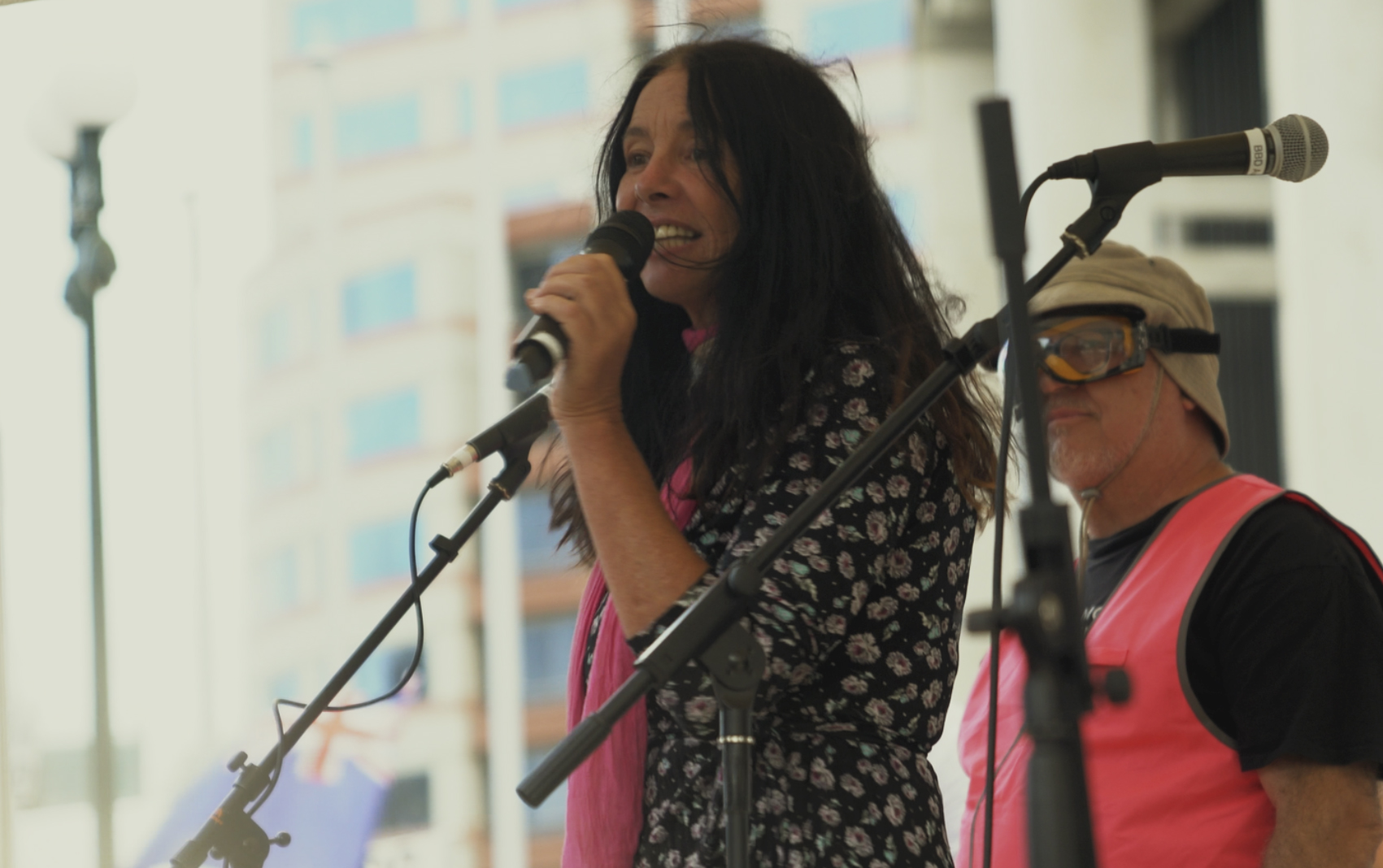
Memories of the convoy
voices
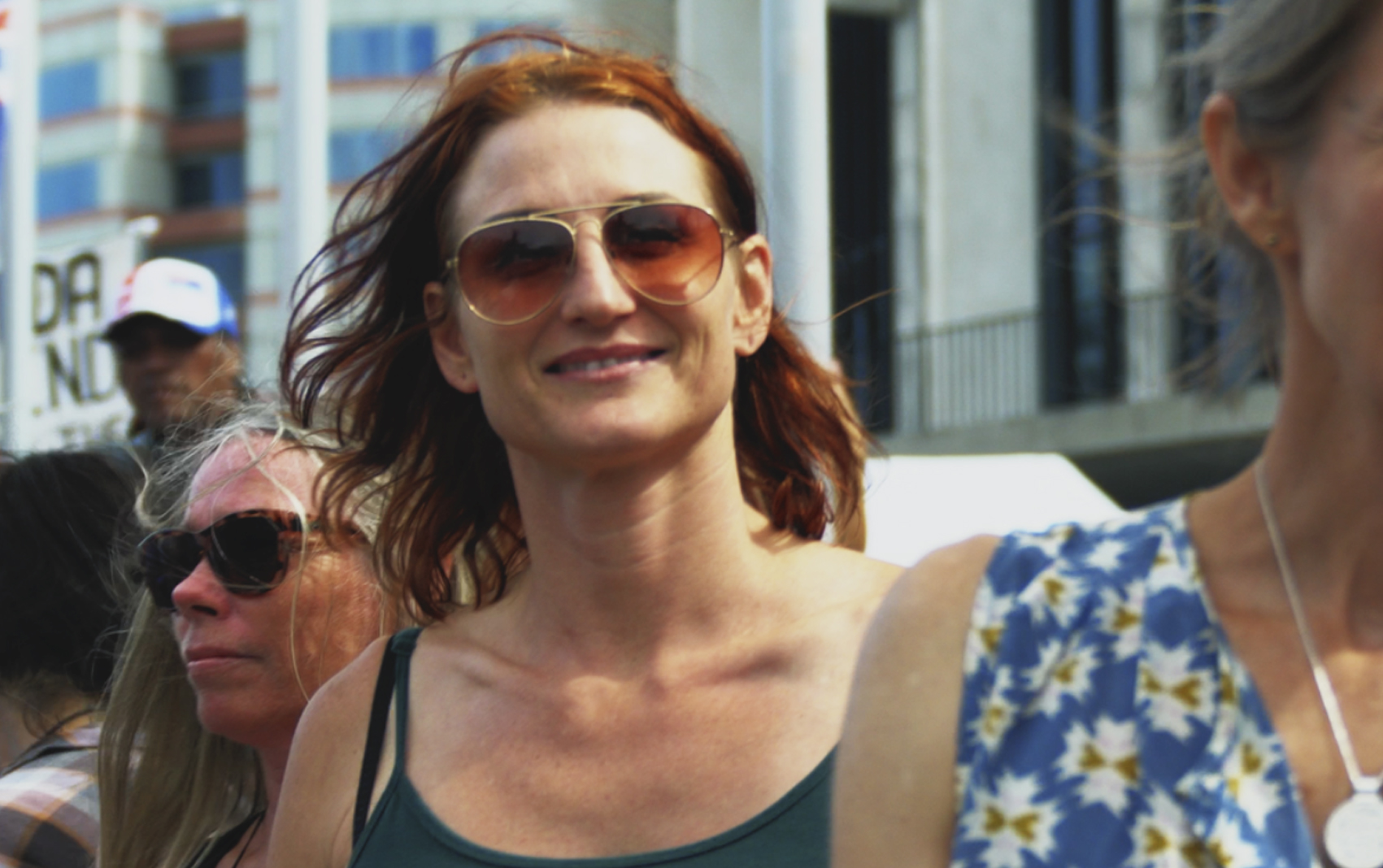
Memories of the convoy
voices
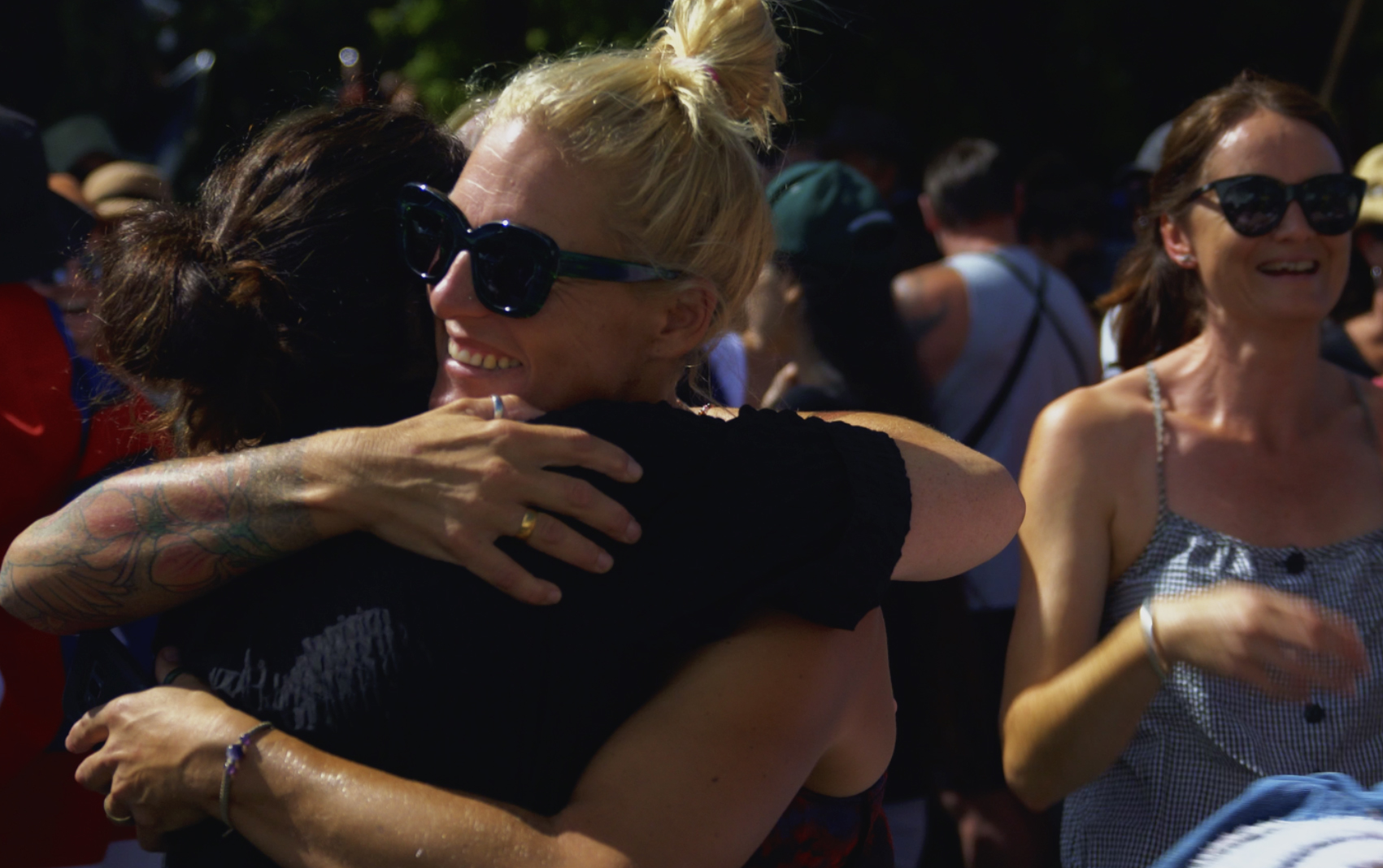
From the convoy to the village
voices
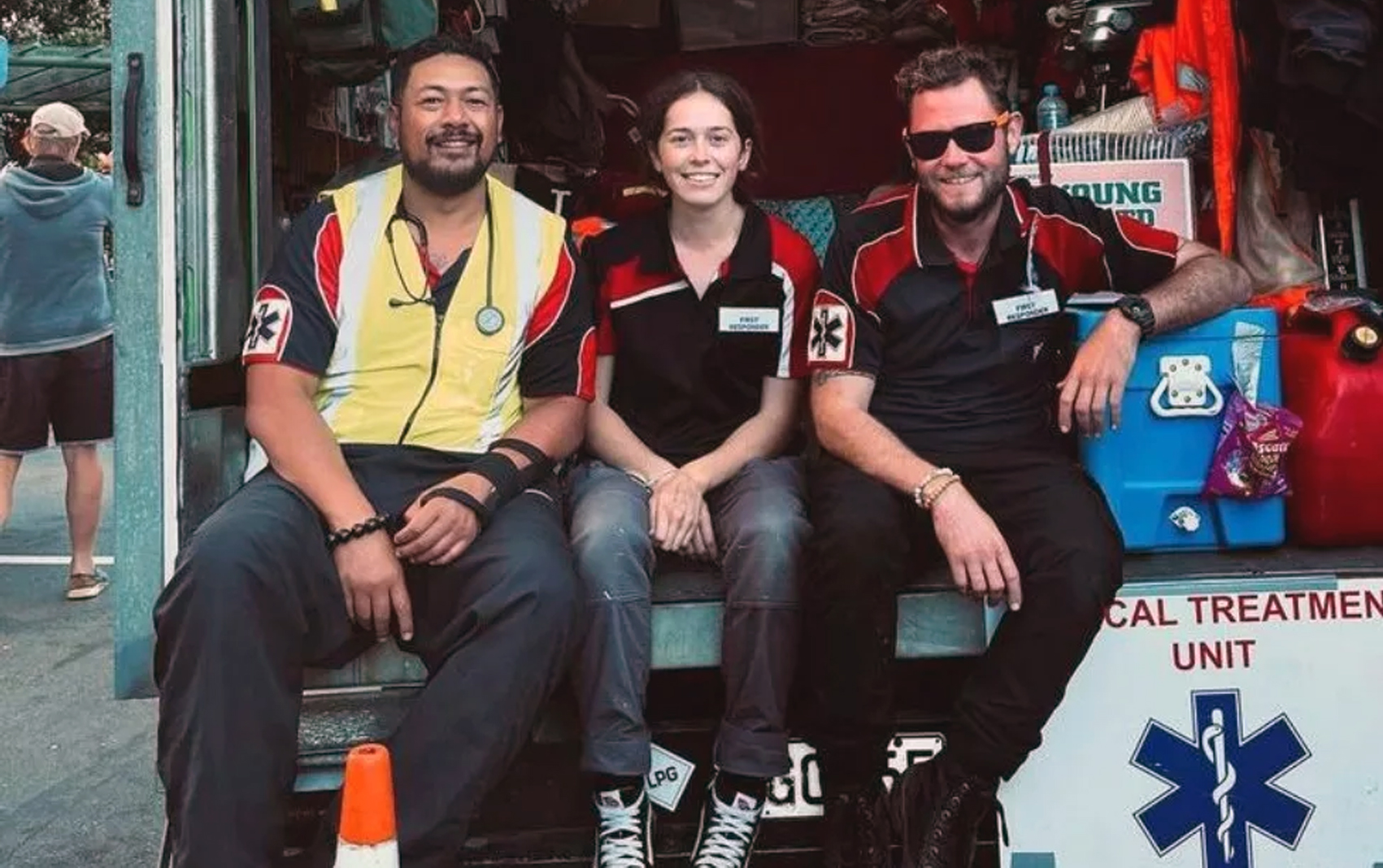
My reasons for going
music
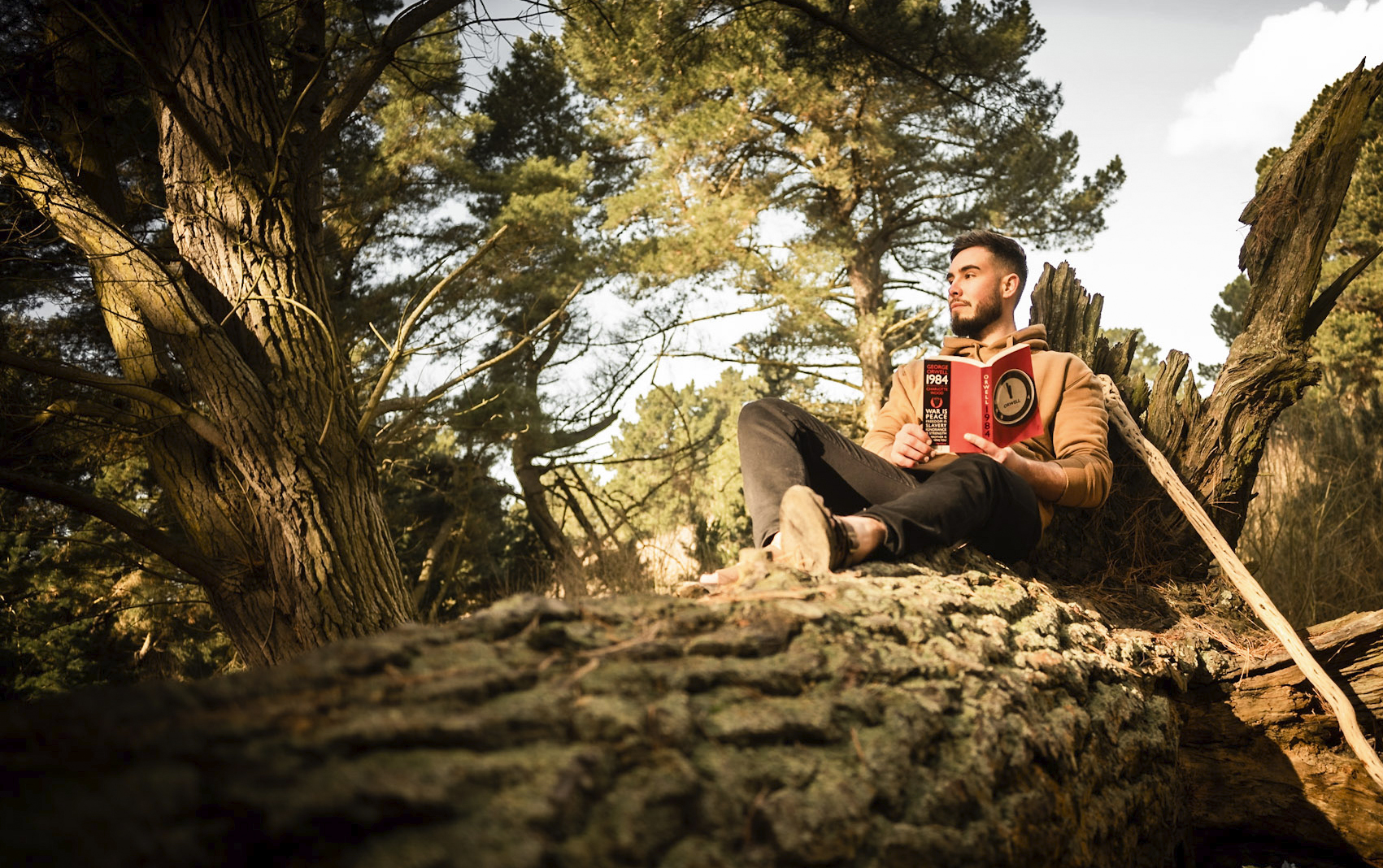
Opponents of Truth
Opponents of Truth
By Brody
Opponents of Truth was made to inspire people to take a stand against the corruption happening to us for our beliefs, and bring all of New Zealand together in a time when it’s incredibly important to support each other. After watching the live streams of the protest in Wellington I was so proud of everyone who stood their ground while they were under so much pressure from the police, government, and slanderous media. I felt we needed more musicians and songs that could be played/performed during these type of movements to boost the morale of anyone involved. Uplifted by the courage of everybody fighting for freedom around the world, this track was born.
voices

No one is here to observe
voices

Kotahitanga
voices
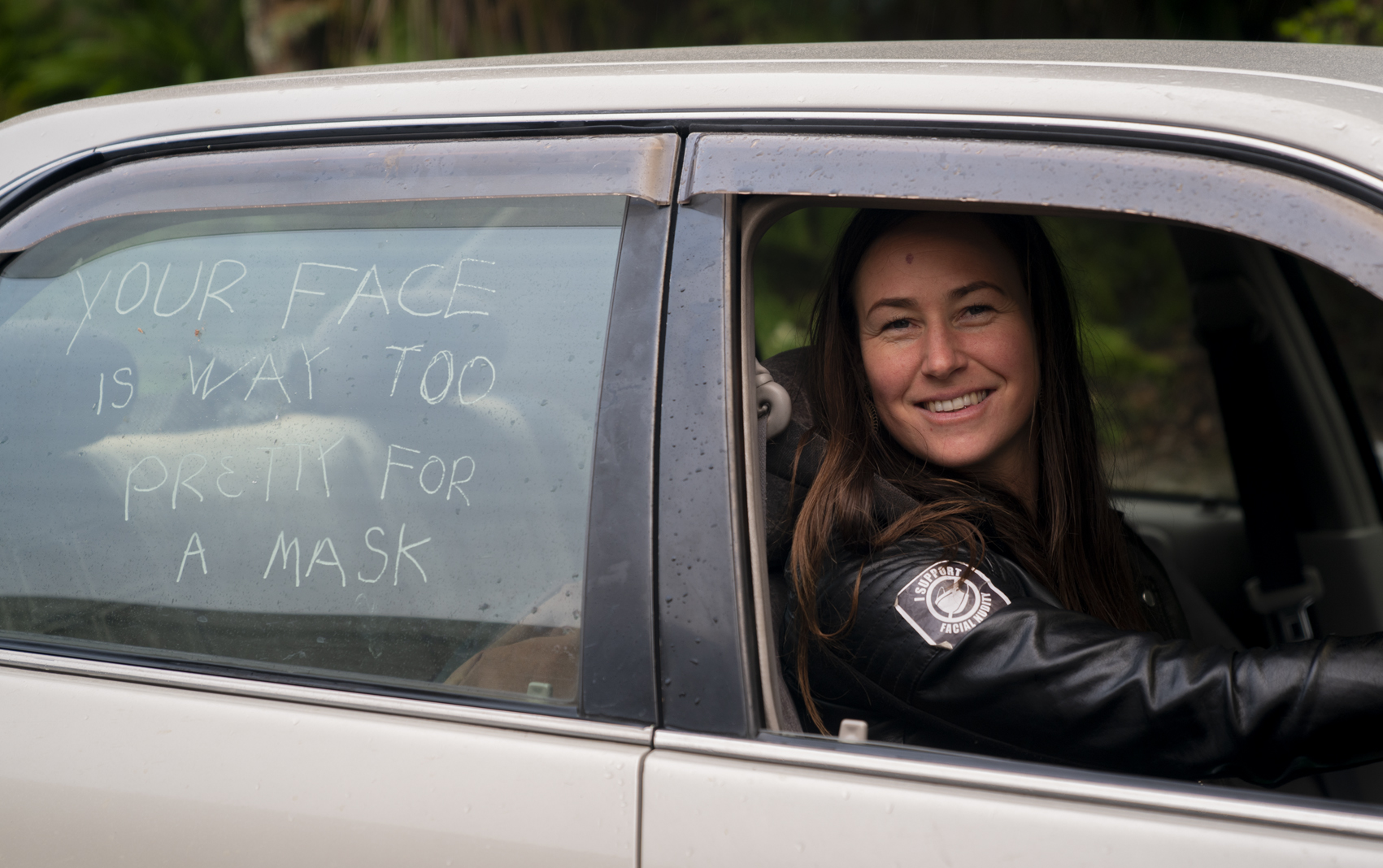
Our last resort
voices
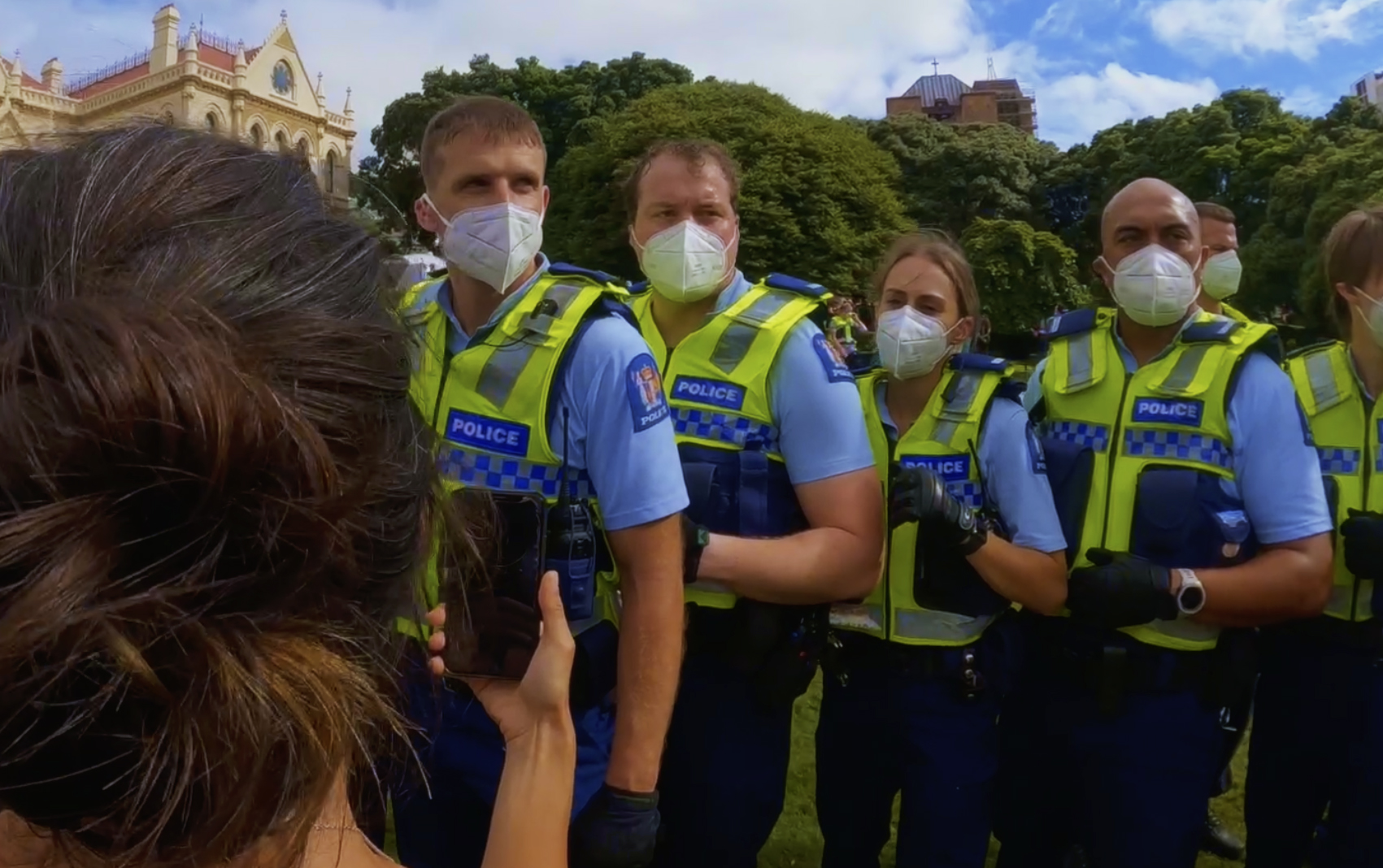
February 10
voices

Being arrested
voices
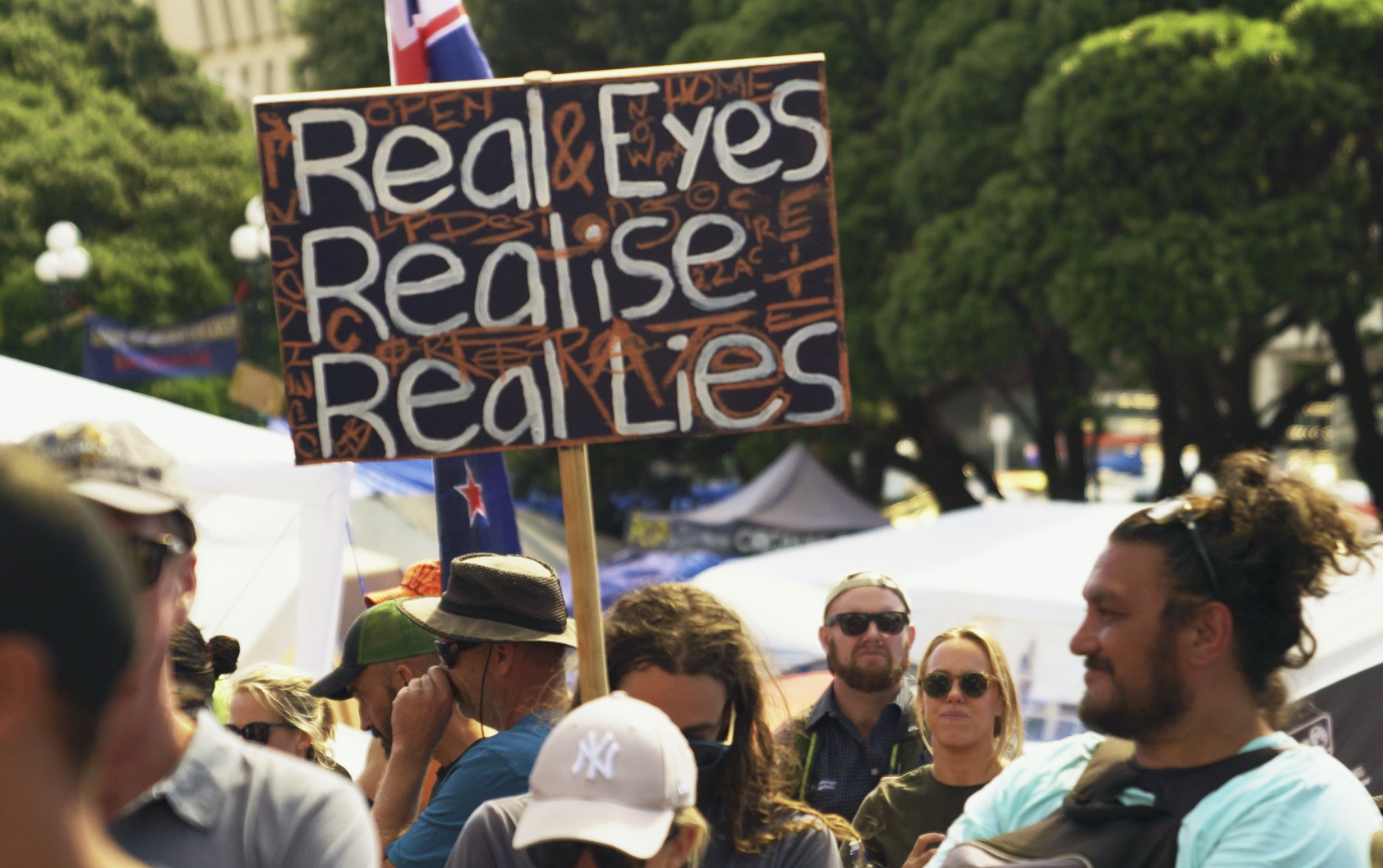
Making change
voices

Their legacy is division
music

Freedom
Freedom
By Fleur Doree
The song ‘Freedom’ was inspired by the Anti-mandate protests. I sung it at the Picton Protest Camp and a lot of other freedom festivals in Christchurch along with the rest of the songs I wrote for an album inspired by the protest movement and dedicated it to my 22-year-old son who passed suddenly in January 2021 in Australia right in the middle of the pandemic. The lyrics of Freedom say it best for me:
I’m praying for the homeless people, praying for the lonely people, now praying for the hurting people, praying for the dying people, now I’m praying for the homeless people, praying for the hungry people, now praying for the crying people, praying for the suffering people now. I’m praying for the people. Can you hear the people? Can you hear them crying out?
That’s what the protest ended up like – a lot of people hurting, and no one listening.
You can hear and purhcase the full album of songs at https://fleurdoree.bandcamp.com/album/freedom-the-uprising
writing
Covid School
By Cassandra
I feel the eyes peering at me sideways. Palms move in front of hissing toxic mouths. Cruel smirks. People savouring the gossip. I walk into the staff office and see incriminating eyes on me. The chatter halts mid flow. What had I done? Nothing, except to say no. I feel the pressure striking me from all angles. The anxiety hurries my pulse, my heart pumping in my ears. There is no sympathy here. Just a blank set of stares stamping me as an outsider.
… Read more
writing
River of filth, or river of freedom?
By Peter
The Wellington protest camp of February 2022, and its fiery ending on March 2nd is now etched into NZ history. But what should our history books say about this event? Was it really as the government and the mainstream told us? Or did those two entities combine to create a false or misleading version of what was really happening? The truth of this historic event needs to be properly understood, and it needs to be understood why this is so important.
… Read more
writing
A freedom diary
By Robyn
Sunday, 6 February 2022
A friend picked me up and we headed to Milton to join the Convoy 2022 which had started in Bluff earlier that morning. We waited in Milton and more vehicles arrived and we all stood around excitedly waiting in the street and chatting. When the main convoy arrived there was much cheering and tooting and excitement was gathering. We really enjoyed the whole experience and it was heartening to see so many people standing on the roadside, on utes, at corners, babies, children, parents and grand parents, holding signs and blowing us kisses. One lady, obviously a grandmother, was holding a toddler and had a 3 yr old at her knee. I called to her to look after those children and she had her hand on her heart and was crying. Very moving to see the emotion these people displayed.
… Read more
writing
My story
By Alan
It is now a year since my hip replacement at Wellington Hospital. The fractured hip was caused by the riot police on Hill street at 6.15am on March the 2nd 2022 but the hip operation was not for a few days later. We still are waiting for the police and their lawyers to consider what they are going to do about it. I cannot do most of the things I used to such as walk on rocks etc… that I did most of my life as a fishing and hunting guide. The police have acknowledged they did break my hip but have said it was my fault for being there. Obviously we don’t accept that sort of rubbish.
… Read more
A river of filth, or a river of freedom?
By Peter
[ first published in The Daily Telegraph at https://dailytelegraph.co.nz/news/river-of-filth-or-river-of-freedom/ ]
The Wellington protest camp of February 2022, and its fiery ending on March 2nd is now etched into NZ history.
But what should our history books say about this event? Was it really as the government and the mainstream told us? Or did those two entities combine to create a false or misleading version of what was really happening? The truth of this historic event needs to be properly understood, and it needs to be understood why this is so important.
The NZ government labeled the Wellington camp a ‘river of filth’, filled by a few hundred disgruntled ‘anti-vaxxers’ with extreme views such as racism and fascism, and with potentially violent tendencies. Therefore they were deemed by the government as not worthy of even being spoken with and listened to by anyone inside the Beehive. The mainstream media sent out the same messaging on a daily basis, and have followed this up with their recent documentary ‘Fire and Fury’ to further reinforce this narrative for our history books and to cement these perspectives into the psyche of the NZ public. But is this really what happened in Wellington? Kiwis deserve that our history books tell the truth about this event, as best and as fairly as possible. It may end up being one of the most pivotal events in NZ history, so it deserves another side of this story to be told and considered.
I provide these perspectives as someone who was camped in my tent at the Wellington camp for several days towards the end of the three week event. I also watched the daily live-stream coverage and real time interviews provided throughout the three weeks by NZ’s independent media. This was coverage and perspectives that the government and mainstream media did not show to the NZ public. I also spoke at length with some of the ‘leaders’ of the gathering.
So what were the people like who were at the Wellington camp? The government have told us that they were extremists, racists, fascists, and violent. Personally, I am none of those things. In fact I am the complete opposite of those things, and so was pretty much every person at the Wellington camp. I grew up in NZ in the 70s and 80s and I grew up in a country where NZ and Kiwis were admired around the world for their incredible friendliness, their desire to go out of their way to help anyone, anytime, no matter who it was, and their pioneering ingenuity to just find a way to get things done. The number 8 wire mentality. If you created a hypothetical spectrum of all people across society, with one end of that spectrum being nasty, violent people, and the other end of that spectrum being peaceful, generous, community minded people like our 70s and 80s folk above, then just about everyone at the Wellington camp was at the far end of the ‘nice, peaceful, community’ end of that spectrum. They were the true blue Kiwis that I grew up around in the 70s and 80s. These things are never 100% with large gatherings of people. But that was the overriding make-up of the people in the Wellington camp.
They were Kiwis from every segment of society. Doctors, nurses, pharmacists, teachers, builders, plumbers, firefighters. All races and ethnicity. Many of them had declined to take the COVID vaccine, for many different reasons, and many of them had actually taken the COVID vaccine. They weren’t ‘anti vax’, they were pro freedom of choice. It wasn’t just about the vaccine mandates. The mandates were just the straw that broke the camel’s back. A critical line had been crossed of aggressive command and control government that was unacceptable to the principles of true Kiwis with that spirit of the 70s and 80s I have described.
So that is who the people were who were in Wellington. But why exactly were they there, and how did it happen?
Hundreds of thousands of these Kiwis, perhaps a million, had been demonized and dehumanized by the NZ government and media. A ‘pandemic of the unvaccinated’ we were all told (it is now accepted across the world that the COVID vaccine does not prevent COVID or stop transmission). These people were effectively cast out of normal society through the vaccine passports and mandates, and were dehumanized into second class citizens. Kiwis were turned against Kiwis. Tens of thousands had lost their jobs and their careers, including critical workforce of doctors, nurses, teachers, and firefighters. It was essentially apartheid in NZ, and the NZ Prime Minister had confirmed on camera to the nation that this was exactly the intention. When I was growing up in NZ in the 70s and 80s, if you had told me then that brutal policies of segregation and apartheid would come into NZ to create two classes of Kiwis within my lifetime, I would have said you were crazy. Impossible. I would have said that NZ are the ones who help other countries fight against these awful things. I would have said that Kiwis stick together through thick and thin. That is the Kiwi way.
So that is why these people were there in Wellington. They were there because they could see no other option. They came to parliament to stand together in solidarity with other like-minded Kiwis who valued what it was to be a true Kiwi. It was spontaneous and unplanned. No one had planned to build a semi-permanent ‘freedom village’ right outside parliament. It just happened. A spark was lit across the country and it just took on a life of its own. The Wellington camp didn’t contain just a few hundred disgruntled extremists as the government and media told us. At its peak there were perhaps as many as 15,000 people there, from every segment of NZ society. This number fluctuated over the three weeks, and then slowly declined to a few thousand in the later stages.
Leading up to the Wellington gathering, two massive convoys of vans, caravans, and cars had earlier been organized and formed. One starting from Cape Reinga at the top of the North Island and the other one from Bluff at the bottom of the South Island. These two convoys grew to become absolutely enormous as more vehicles joined them along the way. There were thousands of vehicles as they made their way down the North Island and up the South Island towards Wellington. Through the length of the country the two convoys passed by huge numbers of people who came out to line the roads in support as they passed by. There were tens of thousands of Kiwis, maybe hundreds of thousands, up and down the country lining the roads to waive the freedom convoys by. It was probably the largest nationwide protest rally in NZ history. That amazing story was barely even mentioned to us by the government or mainstream media. Those coming from the south arrived in huge numbers at Picton. Many couldn’t get across to Wellington on the ferries because of the vaccine passports. So Kiwi boat owners in Picton took some of them across to Wellington themselves. That good old fashioned Kiwi spirit kicking in.
The Wellington gathering began on February 8th, and the numbers were huge. But it was totally peaceful. In fact the messaging coming from everyone in the gathering was that no matter how much provocation or attacks there were by the government and police attempting to break things up, those attacks on them must be met with nothing but peace. That was the overriding, number one priority that was understood and adopted across the camp. In fact, it went even further than that. There was an understanding that if any individual did get overwhelmed by a challenging situation with the police and got angry or ‘over protective’, then others would step in to shield or remove that person from the immediate situation until they calmed down. I witnessed this very thing happen on two occasions while I was there. Both situations were quickly shut down and diffused by those around to help. It was clearly understood by everyone there that if the campers were seen to be aggressive in any way towards the police then this would be used against them by the government and the media.
On Day 3 (February 10th) the government and the mainstream media will tell us that this was the day that the gathering turned violent and out of control. It was not. It was in fact a day that hundreds of good, true spirited Kiwis joined together and showed the most tremendous courage, peace, and unity that has been seen on these shores. It was something that was on one hand truly incredible, and it was on the other hand something that was absolutely horrific and shocking for our country.
The government had decided that the Wellington gathering needed to be broken up and dispersed. The police were going to enter the camp area in large numbers and break it up. The campers could see what was coming and hundreds of them, perhaps a thousand, linked arms to create a human wall between the gathering police and the camp area. The human chain of people was many people deep, all locked arm in arm. They were peacefully making their stand. Peacefully uniting to draw their collective line in the sand. The understanding across the group was that no matter what the police did to someone in that human wall, there would be no reaction. If someone was dragged out and beaten, they would be allowed to be taken out without a fight. Even if it was a family member or friend being beaten and arrested.
Linked arm in arm that human chain faced the gathering numbers of police and they sang songs. They sang the national anthem and they sang songs of peace. Then the police launched into them, trying everything to break the line. They picked out individuals, dragging them out and beating them, many of them brutally with serious injuries, and arresting them. 122 in all were dragged out and arrested. But the human chain would not buckle, and it would not react to those getting dragged away and beaten.
For hours they stood there in their hundreds, arm in arm and took the pounding peacefully. But they could not be broken. The police were doing what they were instructed to do, but many were clearly not comfortable with it. Allegedly 12 of those police officers resigned that night, and currently there are over 1,000 official complaints of unlawful police brutality being processed and investigated. The courage, strength, and unity shown by those hundreds of Kiwis on February 10th, and the inability of the police to break that human chain, is what allowed the Wellington camp to then take hold properly in the semi-permanent fashion it did over the next three weeks through ‘unofficial agreements’ between camp leaders and the police.
Following the February 10th events, things then shifted from Kiwi courage to good old fashioned Kiwi ingenuity and cooperation. Within just a few days the Wellington camp was transformed into a fully functional community ‘town’, with everything a fully-fledged town would have. There were multiple Food Halls, a music and entertainment theatre, medical and health rooms, a crèche, a yoga and well-being studio, a sport and recreation area, a phone charging station, and much more.
It was Kiwi ingenuity and cooperation at its absolute finest. It was able to be done like this because there was professional expertise there from every segment of society. People who had been mandated out of their professional careers were now putting their skills and expertise to use in a new way. There was no complicated, bureaucratic government planning and oversight of the creation of this incredible little ‘town’. It just happened spontaneously through Kiwi ingenuity and community cooperation.
Trevor Mallard and the government tried everything they could think of to undermine what was taking place, including turning the sprinklers on. But everything that was tried was met with the same Kiwi ingenuity. The plumbers and firefighters within the camp quickly created innovative solutions to Trevor’s sprinkler antics, and the children just danced in the water.
Was there a ‘river of filth’ flowing through the camp? Absolutely not. But the government did try their very best to try to create that ‘river of filth’. The government attempted to prevent the portaloo cleaning trucks from entering the camp area to maintain the portaloos. But once again this was met with amazing Kiwi ingenuity. The builders and plumbers within the camp joined forces and within just a few hours they had sourced the required products and equipment and had built two fully functional, plumbed in and flushing toilet blocks in the middle of the road in front of parliament. They had tapped into the Wellington water mains, and then plumbed the new flushing toilet blocks into the Wellington sewerage system underneath the street. The attempted ‘river of filth’ by the government had been thwarted in a cooperative operation of pure Kiwi brilliance.
The provision of meals at the Wellington camp was nothing short of incredible. The Food Halls at the camp provided thousands of free cooked meals every day to all campers who wanted it. Breakfast, lunch, and dinner for thousands of people every day. The food supplies and resources were donated and transported in to the camp every day from supporters from all over the country. Then a small army of volunteer helpers in the camp would process and provide the meals to the campers three times a day. It was a military operation of military scale and efficiency from right across the country. An incredible accomplishment by NZ which the government and mainstream media never made any mention of.
So, what did I do during my days at the Wellington camp? According to the government and mainstream media I would have been plotting extremist actions with my fellow violent radicals. No, not really. That’s not really my thing. What I actually did was I had great chats over coffees with a lot of really interesting normal Kiwis, about all sorts of things. I watched in amazement those Kiwis build those toilet blocks on the road. I watched and listened to songs and performances by some very talented Kiwis in the camp’s Entertainment Hall. I watched a Kiwi couple get married in front of thousands of cheering supporters. I listened to groups outside the church singing and praying for the safety and future of the people of the camp and this country. Yes, there were also some thought provoking speeches being made about various political and philosophical issues. But most of all I witnessed my fellow Kiwis working together and helping each other in incredible ways with whatever needed to be done to run and maintain this amazing new little ‘town’. I discovered that the true Kiwi community spirit and ingenuity I saw when I was growing up in the 70s and 80s was still there. It was still alive and kicking in all of these Kiwis who had come together from all backgrounds, from all over the country. It was truly inspiring.
These are the Kiwis who refused to allow that to be taken away from them and their country. They drew their line in the sand and they said NO. It was that message that lit a spark that caught fire across the country. It wasn’t ‘Fire and Fury’ like the government and mainstream media have been trying to make New Zealanders think. Instead, it was the fire of unity and freedom, and a shared objective that these Kiwis wanted to show a different, more ‘Kiwi way’ to the way that the government was demanding and dictating to the country.
There is much debate around exactly what happened on the final ugly day on March 2nd. What we do know is that the overriding intention and objective of the Wellington campers was absolutely peace driven. We also know that the day’s events were started by early morning raids by the police while most of the campers were still sleeping. It also looks almost certain that on that day the camp was infiltrated by what are called ‘agent provocateurs’. Strange people who had not previously been seen at the camp suddenly popped up on that day, wearing masks and looking and acting strangely and differently to the rest of the campers. None of the Wellington campers wore masks throughout the previous three weeks, but these new ‘strangers’ did. Here is footage showing three of those masked ‘strangers’ setting the fire while the line of incoming police has paused in front of them.
From the heckling by the surrounding crowd in the camp it is very clear that these ‘strangers’ and their actions were not at all welcome by the campers around them. This photo below is allegedly one of those three masked ‘strangers’ seen lighting that fire as he walked away from it before someone in the crowd pulled his scarf down to show his face to the 8,000 live-stream viewers watching this at the time through live independent media.
So, was the environment of conflict and violence on that day created by these masked ‘strangers’ who lit the fire, and by other masked and strange behaving ‘infiltrators’ who suddenly popped up at the camp that day armed with objects which they threw at the police? The resulting scenes that we have all seen on TV were used by the government and mainstream media to try to cement their narrative of the Wellington camp being filled by violent extremists and a river of filth. But instead of our history books recording this ‘Fire and Fury’ version of events that our government and mainstream media would seemingly like it to be recorded as, an alternative way of remembering the Wellington camp is this. It was an incredible convergence of many thousands of patriotic and peaceful Kiwis, from top to bottom of NZ, from all segments of the community, who on February 10th, 2022 courageously and peacefully held their ground while under full, brutal assault, and collectively said NO. Then they worked together with amazing community cooperation to create the most brilliant and innovative of Kiwi productions. All supported and resourced from around the whole country, to showcase true Kiwi spirit and ingenuity.
That spirit and that fire was not crushed on March 2nd. All across the country the Wellington camp has been the catalyst for a subsequent nationwide ‘social evolution’. A multitude of different community groups, with total numbers in the hundreds of thousands, have come together around the country to try to create some different directions and different options for NZ. Directions and options that are more aligned with the true values and spirit that were so evident in the NZ I grew up in back in the 70s and 80s, and were so evident in the NZ Freedom Camp in Wellington.
March 2nd, 2022 wasn’t the end of the ‘NZ Freedom Camp’. It was just the beginning. It was the beginning of a ‘River of Freedom’.
My story
By Alan
It is now a year since my hip replacement at Wellington Hospital. The fractured hip was caused by the riot police on Hill street at 6.15am on March the 2nd 2022 but the hip operation was not for a few days later.
We still are waiting for the police and their lawyers to consider what they are going to do about it. I cannot do most of the things I used to such as walk of rocks etc… that I did most of my life as a fishing and hunting guide. The police have acknowledged they did break my hip but have said it was my fault for being there. Obviously we don’t accept that sort of rubbish.
During my four-and-a-half-hour wait for an ambulance, I was in intense pain and eventually my leg stared to go numb. It was cold and drizzling as well. I rang 111 at about 6.15 am and the medics at the protest first aid tent agreed to wheel me down to the end of Kate Sheppard Place which was out of the protest and police operation zone and a safe place for an ambulance to come. It was also a couple of minutes drive from their depot. Despite numerous calls to them by Jules who was a mandated out ambulance staffer, a doctor and the Maori wardens, no ambulance was forth-coming. Police were standing 20 meters from us and had the road to the protest blocked and another group of police were based 50 meters from us. Numerous people were walking down to the railway station of to go to work and things seemed very normal while around parliament all hell was breaking loose.
An ambulance came slowly cruising down the street and our team ran across and talked to the driver through the window. he would not stop except he was forced to by our team of medical people but then drove off slowly. By now I was in intense pain and starting to go into shock. Asked what level the pain was by a doctor I replied 1-10 no it was 15… So despite even a doctor telling the ambulance dispatch center we need one now they did not respond. All the while, parliament grounds was full of medics in green uniforms and they can be seen only meters from me in the video and they did not help.
Eventually after 4 1/2 hours an ambulance did turn up and I have to say the staff were excellent and they gave me pain killers etc to be able to get me onto a stretcher. So full marks to them, they were great.
I was in hospital for 6 days and again I cannot complain about the service and treatment. Wellington hospital was brilliant even while it was in full lockdown. The nurses where kind and took good care of me. So thanks heaps Wellington Hospital and staff.
The police took our van even though it was parked in a legitimate parking space and at best should have had no more than a parking ticket. But no, it was forklifed up and put in a compound. That’s another story but it did provide difficulties to get it returned.
On the way back home to Turangi I was sore and tired and the driving was hurting so Sue who was driving decided I should check into a motel and rest. Even after explaining to the motel owner at Foxton that I was urgently in need of rest she would not allow us to have a room as we did not have vaccine passports. If I knew the name I would tell you as we don’t want any support going that way, but I can’t recall which motel it was.
Well now, one year has passed and the pain is now all gone. I am still struggling to do many things, but everyday it does get easier.
So great shout out to the ambulance staff who did pick me up, and great shout out to the doctors and nurses at Wellington Hospital. Bad shout down to the ambulance service for ignoring me for 4 1/2hours, to the ambulance driver who wouldn’t stop and to the police medics who ignored me and to the police posted 20 meters from us who did not want to help.
It was a shameful day in New Zealand’s history and more will come out as time rattles on.
And lastly thanks a million for the thousands of get well messages and support. Its brilliant to be one of the freedom family.
A freedom diary
By Robyn
Sunday, 6 February 2022
A friend picked me up and we headed to Milton to join the Convoy 2022 which had started in Bluff earlier that morning. We waited in Milton and more vehicles arrived and we all stood around excitedly waiting in the street and chatting. When the main convoy arrived there was much cheering and tooting and excitement was gathering. We really enjoyed the whole experience and it was heartening to see so many people standing on the roadside, on utes, at corners, babies, children, parents and grand parents, holding signs and blowing us kisses. One lady, obviously a grandmother, was holding a toddler and had a 3 yr old at her knee. I called to her to look after those children and she had her hand on her heart and was crying. Very moving to see the emotion these people displayed.
We proceeded through Dunedin and further north with more vehicles joining in along the way and many more people standing on the sides of every road and on the overbridges. Vehicles tooting and people cheering and clapping. I have never felt so proud. When we reached Oamaru we turned off north of the town and returned home through Kurow, Omarama and back to Central Otago. Many vehicles had also gone up through the centre and joined the Convoy at Oamaru.
Thanks so much Vickie for taking me on a journey of a lifetime. I will never forget that experience.
Wednesday, 23 Feb 2022 to Sunday, 27 February 2022.
A friend and I flew Jetstar from Queenstown to Wellington armed with our “vax passes” and our “negative RATS test”. No problems at the airport and after 1.20 min flight to Wellington, Friend picked us up before having a lovely lunch at the Gypsy Kitchen. We were dropped off at the Waterloo Hotel and Backpackers in Bunny St, a block from Parliament Grounds. It was so handy being close to the action. My son from Auckland was at the protest and had been since the first Friday. He and his friends had established a makeshift camp from a large tarpaulin and a couple of small tents. It was well set up and they were very comfortable with every gadget you could think of. I was very proud of him as he stood by his convictions and believed in what he was doing there.
One of his mates, Phil, known as Portaloo Phil, had been arrested a few days earlier for obstruction (he was protecting the portaloos in the line) and a police thug had eye gouged him. His eye was black, purple and every other colour that goes with that sort of injury. He was lucky he didn’t lose his eye. I was appalled that a policeman could do that to a fellow NZer.
I wandered around the village and was heartened by the whole set up which kept evolving every day. The love and acceptance demonstrated by all to all was something I had never experienced before, ever.
I met a little old lady and her caregiver who was pushing her around in a wheelchair. She lined up beside me in the Hari Krishna lunch queue and we chatted. She was 94 yr old from Foxton and this was her third time at the protest. She lived in a retirement home and was the only one of 260 residents who was not jabbed. She was banned from using all the facilities at the home which she paid for in her weekly rental. She was going home to work out how much her rates were, pay them herself then deduct an amount she thought fair from the rest as she couldn’t use the facilities. So sad that she still had to fight for her rights at her age but I loved her guts and grit. Wished she lived closer to me, I would’ve visited her.
Standing under the trees were 4 nuns, 3 priests and a Reverend Father. I pondered their presence for a while then asked a nun if she was actually in dress-up. She laughed and said they had come up from Christchurch where they attended all the protests. They were all unjabbed and struggled within their church and regarded as outsiders, something most of us understand. They mingled with everyone for 2 days and the Reverend Father gave a very powerful speech from the podium, quite damning to our PM. I even saw a nun playing basketball with the kids right under the beehive. It was a real boost to see people of the faith also taking a stand against the mandates. One nun also said they did not discriminate in their church and everyone was welcome to worship. Such a wide range of attitudes and rules. No consistency.
I kept getting drawn to the Health Forum tent where a display of vax injured people on posters hung around all the walls. I saw Ben Jonutz’s poster from Alexandra there amongst the injured and also Rory Nairn, the young 26yr old from Dunedin, who died from a heart attack due to the jab.
This tent was manned by several women and doctors who you could chat to and it was always busy. Opposite this tent was an area where you could put a cross amongst the shrubs adding a name of someone you knew had died just after being jabbed. I added one for 68 yr old man from Alexandra who had his jab 2 days before collapsing from a massive heart attack which sadly killed him. No history of heart disease. As I was doing this 2 young girls walked past me, stopped then came back and hugged me, their eyes filled with tears. I explained that I didn’t know him that well and they said ” it doesn’t matter, he died.”
My sister was very critical before I left saying that it was no place for kids at a protest. I found the pre school kids tent and took a photo. The kids were lying on their tummies drawing and cutting out and being supervised by a fully qualified teacher. Their Mums were sitting around the edge of the tent watching. I sent my sister the photo showing those “poor” wee kids, having fun, well supervised and SAFE.
Other kids were being taught skateboarding by a young woman who had to close her business as she was mandated out. She needed a ramp and after asking for one at the admin tent, it just appeared. Kids were playing basketball with a hoop just below the beehive, others were drawing on every possible surface with chalk and some of the artwork was exquisite. 2 little boys had each found a bread crate and made them into seats on their little scooters. They were racing down the street having the time of their lives.
Someone had brought in a trampoline and this activity was being supervised by parents to ensure the safety of the kids. Next to a building was a tiled water area which had been plumbed up by tradesmen and the kids had a water pool with a hose and about 8 of them were really enjoying themselves. I never saw one kid on a device while I was at the protest. If the wee ones got displaced they had their Mum’s phone number written on their wrist and they were soon returned to their rightful owner.
One little girl had a trolley with sides on it and was pulling two infants tucked up in blankets around. Safe and snug.
Everyone looked after them, just like it used to be years ago. The poor wee kids, indeed.
There was a massage tent offering about six different treatments, all for free. This was very popular and you had to book for a appointment. The Hari Krishna tent had drums and cushions where you could meditate and chant and this was also very popular. A fully equipped tent with doctors, nurses and chemists was available and nearby was a tent for supplements from herbalists, naturopaths etc where you could tell the attendees what your concern was and they would dispense what they considered appropriate.
An administration tent had everything there, combs, tooth paste, toothbrushes, hotties, pens, lip balm, sunscreen and so many more things, all donated and given away, free. If a tent needed a kitchen sink all they had to do was ask and within a short time it would be delivered. Amazing. A security tent next door was very busy and if anyone lost anything or someone saw something that didn’t look quite they reported it and it would be investigated. Many people, including my son and his friends, took shifts at night time to do security on the gates and around the village to ensure everyone was safe. But people were so honest. Car keys, phones, anything misplaced would always be returned to their rightful owners. I was so impressed.
There was a large tent full of donated clothes and these were especially appreciated that first weekend when Mallard turned the sprinklers on over the people in Parliament grounds. And then there was the storm that followed so spare clothes were essential. A guy travelled from further north with 2 clothes driers and a generator in his truck and continually dried clothes for the protesters. Of course this would not have been necessary had the Speaker of the House acted like an adult instead of a bloody psychopath. What disgusting behaviour from one of our politicians who is meant to be helping to run our country. And the rest of them stood by and watched it happen. Guilty.
There was a Voices For Freedom tent selling t-shirts then a couple of guys came in with boxes of bright orange t-shirts with Convoy 2022 Freedom and a picture of the beehive on it. Free or a donation and they were coming back the following week with more and larger sizes. In the next half hour the whole crowd changed colour wearing bright orange t-shirts. Looked impressive.
There was a tent with non-stop music all day, and a blackboard concert produced some amazing talent. In another tent there were books where you could write your story. And we all had a story, lost jobs, lost friends and family, loss of sports activities and many other losses. And discrimination stories abounded. Yes, we all had a story.
There were 3 main cook tents and all food and labour was donated. One tent fed 2000 pax one evening and 1500 pax for lunch. There was a stainless steel cylindrical container where 100s of chicken legs were cooked. Chops, sausages, saveloys, bowls of different salads, sometimes dessert, fruit, muesli bars, cakes, hot cross buns, tea, coffee and chocolate. Fresh water was on tap all day and replenished as soon as the container was empty. Kids were walking amongst the crowds offering plates of buttered hot cross buns and women circulating through the crowds with plastic wrapped sandwiches. On our first day on our way to the protest a woman came up to us with food in a bag. We were puzzled but soon realised that this was going to be the norm for our stay. I even saw this happening on the live stream during the riots on 2 Mar.
The Hari Krishna tent served vegetarian meals and before lunch was served daily at 1pm, a prayer/chant was held along the queue. Then you moved along and picked up your very full paper plate of food and plastic/wooden cutlery.
My son spent a lot of time in this tent cutting up vegetables as he enjoyed helping and also the company. We then found somewhere to sit either on a chair or on the grass. But always bedside someone you hadn’t met before and before long you were sharing a story with a complete stranger who became your new temporary friend. Before you could get up to find a rubbish tin someone would come up and take it from you. There was never any rubbish around at all. I was asked when I got home how dirty the place was – I replied that it was cleaner than their own backyard. And it was. I never saw any rubbish on the ground. I saw a woman bend over and pick up a small plastic spoon and find a rubbish tin to put it in. My son’s friend couldn’t sleep one night so he found a broom and swept all the footpaths, in the middle of the night. The whole place was cleaner than the streets of Wellington.
The police stopped the sewage disposal trucks coming in to empty and clean the portaloos, something that is a human right and an evil act on behalf of OUR police force. Those toilets had previously been cleaned and emptied 3 times a day and I was more than happy to use them and put my bum on the seats. So the good Kiwi No 8 wire blokes found an answer. I asked what they were doing and they said they were building blocks of toilets. Truck loads of plywood had been brought in and the tradesmen got to work. I took my son back to show him and they had been shifted, no doubt by a few hefty guys, to a few feet away so they could be plumbed straight into the main sewer in the street. Now that made me laugh. The flush toilets were then installed no doubt by registered plumbers and it was a flurry of activity with pipes and men and next minute the toilet was up and flushing. Job well done. These are qualified tradesmen who have been mandated out of their jobs, not idiots like a lot of people think were present at Wellington.
But sadly that night the police came in about 1am, reached over cars with sleeping families inside and uplifted the toilet block with a forklift, smashed them to pieces and took them away on a truck. They also towed the 4-shower block away, smashing windows and causing extreme damage to the block. THEN THEY REPORTED THAT THE PROTESTERS WERE SMELLY AND THE TOILETS WERE OVERFLOWING INTO THE STREET. What disgusting behaviour again from OUR police force to treat THEIR people like that. I cannot believe that woman directed the police force to treat NZers like that. I am shocked and appalled. But this was NEVER reported on the 6pm News on Ch 1.
The police would also not let the truck in to collect the full skip bin which had become smelly and extremely unhygienic. A tarpaulin was put over it but the smell was extreme. AGAIN, HOW COULD THE POLICE DO THAT. I believe this was reported by a protester to the Health Department who then had to act and the skip was taken away.
I also heard that the protesters were putting sewage straight into the harbour. Obviously that was from someone sitting in their lounge somewhere in New Zealand watching Ch 1 news which of course the well informed know is owned by the Government who direct what is to be reported. Disgusting.
I saw a builder from Cromwell, installing a sink bench for one of the kitchens so dishes could be washed in hot water. Every necessary system required was provided. They had also erected a back wall in the tent so that shelves could be installed to put food and utensils on. Again these were tradesmen who had been mandated out of their jobs, good Kiwi blokes with a very practical, can do attitude. Loved those guys.
There were 2 hairdressers working full time and a barber was so busy with haircuts and beard trims. And they were smiling and having fun.
I spoke with two doctors and a chemist who had all been mandated out of their jobs. One of the doctors had addressed a meeting at the Invercargill City Council before Xmas.
Everyone was hugging, crying, laughing, dancing and displaying every possible emotion mostly with total strangers.
Speeches were made from the podium every day interspersed by singing, wiatas, prayers and everything else.
And there was even a wedding. A couple had caught one of the 20+ private boats provided by the public (including a large fishing boat which had come up from Greymouth) to transport the South Islanders across Cook Strait because unjabbed people weren’t allowed to use the ferries.
We all waited with baited breath, the bride turned up then the groom and we were all witness to a very lovely wedding undertaken by a marriage celebrant. My son and I then came across the wedding cake out the back beside a cook tent. We waited to watch the cutting of the cake but they were being interviewed so we wandered off. But it was very special.
On Friday afternoon, I went for a walk up Lambton Quay and stopped outside a chemist shop where there was a very large Islander acting as security guard. I soon concluded that all the people going in and out of the shop were lining up for their booster shots. I just wanted to scream out and tell them to go home as it didn’t work, was damaging people’s health and killing some people. The security guard agreed that it was wrong even though he would have been triple jabbed in order to have that job. An Asian woman and her teenage daughter came out of the chemist, the latter sporting a small bandaid on her top arm. She had obviously just been jabbed and Mother gave her an encouraging hug. I felt sick. I continued down the street and was shocked at how few people were in some of the big department stores. Many cafes and restaurants were closed and advertising for staff. There were hardly any people on the footpaths. And this had NOTHING to do with the protest in spite of the lies that was again reported on the Ch 1 news because these shops were well away from Parliament grounds. This whole issue is crippling the country.
On Friday night, I returned to the backpackers about 9pm and there were 3 police outside, an ambulance just pulling out, 6 police inside and towels all over the floor near reception. The security guard escorted me across the foyer to the lift and came up to the 4th floor with me. I asked what had happened and he said one of the permanent residents had an altercation with another. My friend came home about an hour later and she and several others were locked out for 3 hours. It turned out that the same offender had later stabbed another victim about 40 to 50 times and he was in a critical condition in hospital. Next morning I had to use the back staircase as the lobby was locked off for investigations. THIS HAD NOTHING TO DO WITH THE PROTEST.
So it shows that it was safer within the Parliament Grounds with 1000s of strangers than a few yards down the street at a backpackers.
Again, I say this whole issue is crippling the country.
I spoke to 2 policemen on my way back to the Freedom Camp and I commented that I had come up from the South Islanc to see for myself what was really going on as the media were not reporting the truth. They both agreed with me!!
On Sunday morning, my friend and I took an early taxi to the airport, checked in with our “vax passes/or was it the negative RATS test” and returned home. There were many people on the plane who had all been at the protest and they were very noticeable as none of them wore masks. We all know they don’t work. We have FREEDOM.
On Monday morning, I had a bad headache and ached all over. Stayed in bed and concluded I had “IT” whatever IT is. Nah just a flu. No appetite but upped my supplements, fluid and started taking NAC. In and out of bed Tuesday and relaxed for the rest of the week. My sister asked if I was going to the Dr, why would I go for flu like symptoms to be told to go home and rest. So if that was “omicron” then what is the fuss (and fear) all about. My friend developed similar symptoms as did another friend and her family from Millers Flat so we concluded we “caught” something in Wellington. We all spent about a week looking after ourselves and we were all UNJABBED. “IT” has since been running rife around my home town and the rest of the country. It was inevitable. I have heard the triple vaxed people are getting very sick. Of course, because their immune system has been severely compromised by the vaccinations, sadly. We did try to warn them but they are asleep and simply don’t want to hear.
WHEN ARE THEY GOING TO WAKE UP???? It makes me want to cry.
What did I get from that experience? What I saw developing in Wellington was a freedom village. No-one was in charge, people were adult and mature enough to know what was needed and how to look out for each other. The kids wandered around free and safe. I felt safer there than I did in other cities and even in my own small town. And it was so nice just to see things happen.
I never saw any anger until I saw the Police storming the village on 2 Mar on the main stream television stations. And all those plants in there throwing bricks and wood blocks at the Police. And these peaceful, caring, loving people losing everything they had created.
How disgusting. I cried all day.
Covid school.
By Cassandra
I feel the eyes peering at me sideways. Palms move in front of hissing toxic mouths. Cruel smirks. People savouring the gossip. I walk into the staff office and see incriminating eyes on me. The chatter halts mid flow. What had I done? Nothing, except to say no. I feel the pressure striking me from all angles. The anxiety hurries my pulse, my heart pumping in my ears. There is no sympathy here. Just a blank set of stares stamping me as an outsider.
I walk up to Jennifer to beg to borrow her stapler. Her lips twist in disgust. Evidently, I am not wanted here. She tells me, “No, you might get your germs all over it.” before she pulls it towards her like a precious babe in arms. She grabs the nearest sanitiser and squirts some onto her hands as if even being in my presence is enough for her to catch something deadly. She eyeballs me the whole time as her hands religiously spread the alcohol scent over her delicate hands. Lips taut in concentration. The bell rings to signal lunchtime. I jump a little as I am so focused on the waves of disgust rolling off someone I once assumed was my friend. I have lunchtime duty, so I walk out without a word. What is there to say?
As always, I wander past the teens trickling out of class. It is bittersweet to see their laughing faces as they spend time with friends – something quite alien to me now. A group of students I have taught in the past come rushing up to me. “Miss, is it true? Are you leaving?” My heart squeezes as I answer. “I don’t know. I will just have to wait and see. I don’t want to leave.” They already have had many changes in teachers over the last few years, so they are feeling let down. They beg me to just say yes. It’s only a shot! But I can’t. How can I continue to teach them about right and wrong if I crumble? I just want this nightmare to end, but I know I have no choice. With down-turned faces, they scurry away after a quick hug and wave. How I will miss them. Tears prickle once more and my throat feels like it will close up. This is the hardest thing I have ever done.
The buildings, mostly empty now, the juveniles outside savouring the sunlight. I walk past an entrance to hear my friend say to another workmate, “I can’t wait till THOSE people are out of here!” I choose to carry on walking with my head high. What is the point of making a fuss? She is after all the principal’s wife. I already am in enough trouble.
The bell sounds its shrill cry and I reluctantly start to head back to my classroom. My staffroom a battleground now. Cruel eyes glare at me if I set foot in there these days. A place no longer accessible to me. Like a thief in the I night, coffee is a guilty pleasure when I muster enough courage to ignore the disgusted looks and rush in to grab sustenance.
As I head back to my classroom, a lad I only know by sight stops in front of me and snarls, “Good luck with dying from Covid.” I am left struck dumb, knowing that this is coming from a place of hate. But again, what can I do? According to our ministry, I have no rights anymore. My heart is heavy that this is what he is learning. I believed that school should teach children how to be good citizens. Now we are advising them that it’s ok to fear and despise groups of people based upon a medical decision. The flow on effect of a Prime Minister laughing at causing a divided country on national news.
Hands shaking and feeling overwhelmed, I try to head back to my safety. My classroom with all the students’ work displayed proudly on the walls. My Scentsy warmer pushing candy scents into the room. Standing at my door is the principal. His look of pity and disappointment fills my stomach with butterflies. He hands me an official letter stating I have to meet with the board. They have given me notice for refusing to comply with something I completely disagree with. I try to reason with him but his eyes go chillingly hard and I see there is no point. My head bows in defeat and as he leaves, he says, “Have a wonderful day.”
Our family day at the Wellington protest.
[ Written during the protest and first published at https://sojournal.co.nz/our-family-day-at-the-wellington-protest/ ]
Having been affected by the authoritarian and patently unjust vaccination mandates, my family and I were excited to hear about the convoy heading to Wellington and walked up to our local motorway overbridge to cheer them on as they went past on Sunday 6th February. We stood with other Kiwis waving our national flag and holding up a sign that said “No Mandates”. We figured that over a quarter of the cars driving under us tooted and waved in support of our message. What we didn’t realise initially was this was not even the convoy. When the convoy arrived we really knew about it. Vehicles decorated in flags and banners cruised through in one almost continuous stream for over half an hour. We could not believe the numbers.
The Sneering Elite and Deceitful Media
In the days that followed, we kept up with what was happening down in Wellington via Telegram channels and Facebook groups. As a family we were buoyed by the ordinary New Zealanders who were taking a stand for freedom. For too long, we have been dictated to by those who look down on us as lesser beings.
This sneering condescension became clear in the mainstream media’s coverage of the event as well as the unwillingness of any politician to come down and walk among the people they supposedly serve to hear their concerns and hurt. The protestors have been sidelined as non-citizens.
Deliberate deceit was practised. Media claimed that there was no clear message. This despite the prolific ‘end mandates’ messaging within the camp. Violent aspects of the protest were highlighted by mainstream media and politicians in an attempt to invalidate the message of the protest.
Many young liberals sipping their soy lattes and older boomers sanctimoniously wrote off the protestors on Twitter and Facebook while the former continued in their ‘elite’ jobs and the latter pursued life with their income streams largely unaffected by the government’s covid policies.
But the mismatch between live footage from people like Chantelle Baker and the Daily Examiner continued in stark contrast to the mainstream media’s carefully curated portrait of the protest. Probably one of the last straws for our family was the report of acid and excrement being thrown at police. No footage of either of these events has turned up, but one video that seems to corroborate the protestor’s version of the acid event has appeared. It seems quite likely that police were affected by their own pepper spray. Waiting for evidence wasn’t an option for many who seemed desperate to cling to yet another smear which would enable them to disregard the message of the protest with their consciences intact. Few have had the guts to backtrack on their hasty social media accusations and publicly wonder whether there is more to the story than they initially presumptuously posted.
Enough! Let’s Go and Check it Out
It was at this point we began to ask, “Should we go down?” We wanted to see first-hand what it is like. Now as a family of 8, with our eldest 12 and youngest 8 months old, we realised it would be difficult logistically. Being one of the more fortunate ones, I have managed to keep my teaching job (albeit online), so we had to make our visit on a weekend. My wife, an excellent planner organised the trip and we managed to convoy down with another car and stay with some old friends in Fielding on Friday night. Together we all got an early start and made it to the entrance of the protest area at around 10:00am.
The first words we were greeted with as we squeezed between the oblong concrete blocks police had surrounded the protest area with were “Morning” from one chap, and “We love you, what beautiful children” from a woman standing nearby. Soon we passed a couple of workers building a toilet structure which would be completed by the end of our day in Wellington and plumbed into the Wellington sewerage system the next day. We spent the next seven and a half hours walking through the protest grounds and sitting amongst the people there. So let me share some thoughts and observations with you:
Overall Feel
The overall ‘feel’ of the protests was welcoming. Some have mentioned it’s like a festival. People as a whole were friendly, polite and generous. Free food and drink were readily available. Passing one tent I was offered food by a group of Maori adults. There were short queues for Spirulina, waffles and hot cross buns on Molesworth Street near the High Court. The kids loved the raspberry sauce! Up in front of the Parliamentary library, a couple of Christian women wheeled a trolley with trays packed to the brim with baked goods. These were offered around and my family gratefully accepted this hospitality.
People were extremely polite. I was often pushing a stroller with our youngest two in it. Given the crowd it was difficult sometimes to get where I needed to go when following the rest of our crew. However, people made way and had smiles on their faces. My wife had a stranger help her lift the stroller up some stairs.
There were no masks. Oh what joy seeing the smiles on people’s faces and the individuality this allows us to see. There was no fear here. No mindless compliance. There was an understanding of the futility of masks. These people understand the mask has become a sacrament for a faith they don’t belong to; a faith which they reject.
One of the most beautiful things about the protest was the way it seems to have united diverse characters. Walking along past an area of food preparation I saw a Pakeha woman who seemed to come from a middle-class background sitting on the straw with a couple of Maori woman who looked more working-class, chatting and peeling potatoes for an upcoming meal.
My wife summed up her feel of the place by saying that she didn’t fear that she would have her phone pinched compared to more common large group situations she finds herself in. She described it as a “Can I help you?” type atmosphere. It was a giving rather than taking atmosphere.
Standing behind the barriers looking toward the police ‘guarding’ parliament made me feel a little sad. It seemed a waste of police resources, and it looked incredibly boring. One side of the barrier was full of fun, community, music and festivity, the other masked up despite standing metres apart, standing on rubber mats staring straight ahead. To add insult to injury, at intervals, our esteemed Speaker of the House, Trevor Mallard could be heard informing us that the protest on the grounds was illegal and we were all trespassing. I wish Trevor could see the irony of him lecturing protestors on their illegal actions a day after his government’s Police and Defence Force vaccination mandate had been found to be illegal. I imagine however that it is lost on him.
Entertainment
There was plenty of entertainment. There were various speakers including Rodney Hide who we unfortunately missed. There was live music from various musicians. Up near the Beehive there was a wall where artists could use chalk to draw pictures and write slogans. There was a fairly good drawing of Mel Gibson’s William Wallace. A basketball hoop near the Freedom Stairs was constantly in use. One of the highlights for many that day was the wedding of an unvaccinated couple who apparently couldn’t get married at a registry office. I guess this way they could have had more than the regulated number of guests! There was a trampoline on Kate Sheppard Place which catered for many children. Trevor Mallard’s famous slide had a constant stream of children using it. When we stopped for a sit down near some grassy banks, my children enjoyed rolling down these.
So Who’s There?
So what’s the make up of the protest? There are definitely a significant minority of Christians in the protests. One of the first things we did is attend a sort of worship service on the steps of the Parliamentary library. Then there are those of a more alternative bent; hippies if you will. Maori seem to be overrepresented in the population while I noticed Asians and Indians to be less represented than I am used to in Auckland. There was a far higher proportion of people tattooed than I normally see. It seems that the gathering reflected more ordinary, provincial and working-class people than urban elites. Clearly there are capable organisers and skilled tradies involved too.
Incidents of Aggression
In the whole time I was there, wandering around to different areas of the protest grounds, I witnessed two incidents of aggression. As I joked with my friends, there was less violence in one whole day here than there was in any given lunch time at my old high school; Manurewa High.
The first occurred when several police wandered down Molesworth street and onto Lambton Quay. One Maori man began shouting at the police to get off ‘our land’. He referred to some recent event where a group had apparently ‘trespassed’ the police from the protest grounds. The police stood still and faced the man down as he shouted at them. They did nothing aggressive and I heard nothing from them, although that may be because the man was shouting so loudly. Very quickly other protestors gathered. One young man, despite being much smaller, challenged the aggressive man and said something along the lines of “That’s not the way we do things” and earned a shove and verbal abuse for his trouble. The police remained restrained. That was the only violence I saw during this first incident. As more protestors gathered, they began chanting “Peace and love!” They then walked toward the aggressive man and police and the police backed away down Lambton Quay towards Mulgrave street and outside of the protest perimeter. I had my children with me and was within 10m of the incident. I did not feel unsafe.
The second incident was a fisty-cuffs between teenage girls. I have no idea what it was about, but there was a lot of swearing and yelling. This incident ironically occurred outside “Camp Kindness”, a collection of tents on Bunny street outside Old Government buildings. The protest security guards arrived promptly at the scene and took care of the issue. One Maori lady wandering past told me: “It’s OK, it’s just some silly little b*****s having a fight”.
So what do I make of this? There were thousands of people in the protest site. Free food and fun are also attracting people who are not necessarily there because they want the mandates to end. I saw two aggressive incidents despite being surrounded by people the whole day. Sure, not great, but go down to the main street of your city on a Friday night in town or a typical high school at lunchtime and you’d see a lot worse.
To balance this picture out you’d need to consider how the vast majority of protestors treat each other and the police. As police finished shifts, you’d hear protestors calling out to them, “Well done guys, thank you!” As already mentioned, politeness and kindness toward others in the grounds marked our experience throughout the day.
So does aggression characterise the Wellington protest accurately? No. Does it represent the overall vibe of the protest? Emphatically no, of course it doesn’t. Is it unfortunate? Yes of course. But the percentage of idiots seemed to me to be fairly low. In a funny-shaped building nearby, I think the ratio of unpleasant people would be a lot higher than I saw at this protest, but we are all forced to put up with that six-score of people despite the snarkiness we see from them on a regular basis.
Unsafe for Kids?
I’ve seen claims that the protest area is unsafe for kids. My experience during the day was that this is not true. It may of course be different at night time. My children are aged 8 months, 3, 6, 8, 10 and 12 years old. My only concern (as is usually the case in big crowds) for them during the day was the possibility of them getting lost or separated from us. I wrote our number on each of their hands so that in the event of getting lost they could point to their hands and get a passerby to phone us. We also arranged a meeting place.
There were many kids throughout the protest. Mallard’s expensive slide was at least put to good use, reducing the per slide cost considerably. Kids in our group were offered free balloons, stickers, and some weird crystals on sticks – who knows what they were designed to ward off? Passing strangers also gave us bubble wands which our children enjoyed using. Another stranger offered the children a chocolate fish.
Unsanitary Conditions?
Were the conditions unsanitary? In a word, no. This has come up time and time again. It reminds me of Nazi propaganda attempts to smear the Jews as vermin. Sure the area surrounding the port-a-loos smelt like…well port-a-loos. Perhaps some of the precious mainstream media reporters who have never camped at a DOC site and have all their holidays at Daddy’s Omaha bach might consider these conditions unsanitary, but the reality is that given an outdoor camping environment, the place was immaculate. Far cleaner than what you would expect at a large public gathering. Was there excrement on the ground? No. My wife noted a slight odour of decaying straw which I did not notice, but Trevor Mallard can take the blame for that. The place is being upgraded by the talented people living there. Now they have flush toilets installed and a shower block which the police have subsequently destroyed. The only danger of unsanitary conditions comes from police attempts to block trucks from emptying the port-a-loos.
Was there rubbish throughout the camp? No. It was surprisingly clear of rubbish. Every school in the country would have far more rubbish after a lunchtime than I saw in my day there. I saw a woman wheeling a trolley with a black sack on it. It seems there are systems for keeping the campground tidy.
The Eccentric?
Much has been made of the eccentricities of the protestors. This has been used to tar the protest with the ‘conspiracy theory’ brush so that the message of no mandates can be dismissed more easily. Well yes, there were some eccentrics and unusual people at the protest. But again, using the school comparison, are there unusual children at school? Yes. When we have large gatherings do we find people with unusual views? Yes. Go to parliament (or church!) and you’ll find a few eccentrics there.
So who were these eccentrics? I did spot several people wearing tinfoil hats. Now given that I didn’t speak to these people, I don’t know if they are wearing them for what they consider serious reasons or as a send-up for the media. To be honest, there are definitely some conspiracy theorists in some of the groups I’ve joined to keep an eye on the protests and I definitely saw one mum adjusting a piece of aluminium foil inside a hat while standing next to a child.
Then down at the intersection of Stout Street and Bunny street where the protestors waved flags, hands and signs at passers-by while sitting on the concrete blocks police had brought in, there was a middle-aged chap using a megaphone. “Autobots, roll out,” and various other instructions to Transformers were issued at regular intervals. This guy had to be one of the highlights of my day.
Another man, by the look of it homeless, and clutching a packet of cigarettes walked past me muttering to himself about his personal economic situation and its injustice. Then there was a fairly rugged-looking chap driving a beat-up old car with a dead tree (complete with root ball) sticking out the front passenger window with a flag wrapped tightly around its end, who stopped right next to the police blockade at Mulgrave street outside the transport interchange. The tree was removed and brought into the protest grounds. He chatted with the police while his car, hazard lights flashing blocked up one lane momentarily.
Some find religious Christians ‘eccentric’, so I’ll mention the evangelicals singing songs up near Parliament Library. There were also a group of Catholics holding a crucifix, a New Zealand flag and a statue of Mary who were marching around the precinct. I was told by some that they were marching around parliament 7 times.
So yes, by the standards of many, there were some unusual events occurring. There were some unusual people. However, it seems to me that some are all too willing to write off the whole protest because there are a few unusual or eccentric people involved. This might be convenient, but it does not take away from the message, and is all part of the fun.
On the Barricades!
Towards the end of our day we decided to head down to the intersection of Stout Street and Bunny street where the barricade of concrete blocks prevented more cars from entering the protest area. A number of protestors sat or stood on these concrete blocks, waving flags and dancing to classics like Dave Dobbyn’s “Slice of Heaven”. This is where Transformer guy was based! A young boy was shouting out freedom and the crowd responded with louder cheers of “Freedom!” As cars went by, many tooted support which caused huge cheers from the protestors, especially when bus drivers showed their support.
So Where is This Going?
The government has continued to underestimate the scale of the situation. The protest is massive. Only by walking around did I finally understand how big this is. Events around the country on Saturday show that support is nationwide.
Additionally, the government and media have also underestimated who they are dealing with. The typical disdain that the ‘intellectual’ class has for those who work with their hands has been apparent. Michael Wood’s comments about a “river of filth” highlight this scorn. Mallard’s stupid decision to use the sprinklers against them underscores that our politicians have not understood who they are dealing with. Like Mallard, I’d have no idea how to deal with a sprinkler system being weaponised against me while camping, and I’d probably decamp. And if new port-a-loos were not provided for me, I’d have no idea what to do, and be forced to head elsewhere.
However, within this community are people who are not only desperate because they have lost their jobs, but also very skilled. They are not mindless rabble or even the silly little girls who attend climate protests while knowing little about science. Many are practical Kiwis who know how to get stuff done. To be honest, the ‘can do’ and ‘know how’ of key members of this group, if moved into the Beehive, would be a welcome relief to the incompetence we have suffered under for so long. These typical Kiwis wouldn’t ordinarily attend protests because they are busy working, minding their own business and keeping this country running. The government, by its authoritarian hubris, has invited this ‘revolt’.
To cap off the day
After a long and tiring day, we set off for Fielding but stopped off on the way back for dinner. This was a little bit of an emotional experience for me. Our friends knew of a restaurant that refused to discriminate. In fact, it’s there on their front door. So for the first time since the wicked discriminatory vaccine passport system was introduced last year, I entered a restaurant and was treated like I was a person. I can’t explain exactly how I felt – the emotions were so mixed: anger that people could be so blind to go along with this injustice, sadness having been treated this way for months, and joy that there are people who are willing to risk great penalties to stand up against injustice.
As a family, we are glad we went and saw this for ourselves. Our children will never forget this experience and have been involved in a small way in what is going to be an important part of New Zealand’s history. More power to the protestors.

Lone Range Forecast
By Lani.
‘Lone Range Forecast’ was created during the second lockdown… that time we got to know the four walls of our lounges pretty well.
At that point, a mountain of my time ensued deliberating on the ‘why’ questions about the virus, but even more so, on the response to it. With an unknown beast and to be told by our Govt that they are the sole source of truth troubled me as did the overt manipulation of our media. I had never witnessed this before growing up in this country, maybe I wasn’t looking for it previously. The more it was in my face, the more questions I had.
Prevented from working I attended the protest in Wellington and was shocked at the media’s portrayal of the event vs the reality on the ground.
How did a polar bear end up being the main character in ‘Lone Range Forecast’?
When the walls of your lounge start coming in and the heat ratchets up, the release valves will often be to fight or escape. To fight a large beast in control of the media and public perception is daunting. The resilient and those who question can always adapt, not too dissimilar to Mr Polar Bear on the couch, but only with early recognition of the beast you are confronted with. The door to a more inviting environment where common sense has yet to melt, should always remain open in New Zealand.

One Source of Truth
By Shaun.
I was an art student in Wellington during the protests. I attended a few times, and each time I was blown away by the camaraderie and commitment. The energy was infectious – unlike the virus!
For our study we were asked to produce a series of 3 works on a subject. I made 3 sculptures based on covid. I may not have made many friends amongst my classmates, however they were still relatively supportive, despite not agreeing with my sentiment.
“One source of truth” was inspired by a drawing I seen at the protest, I think it may have been a young girl’s work that showed a face with hands covering the mouth. It made me think of the lies and suppression that is being forced on us through the media and from the government.
Although it was cathartic at some level I was emotionally drained after completing the pieces. It took a lot out of me and still affects me. I’m struggling with how far our institutes have been so thoroughly corrupted.
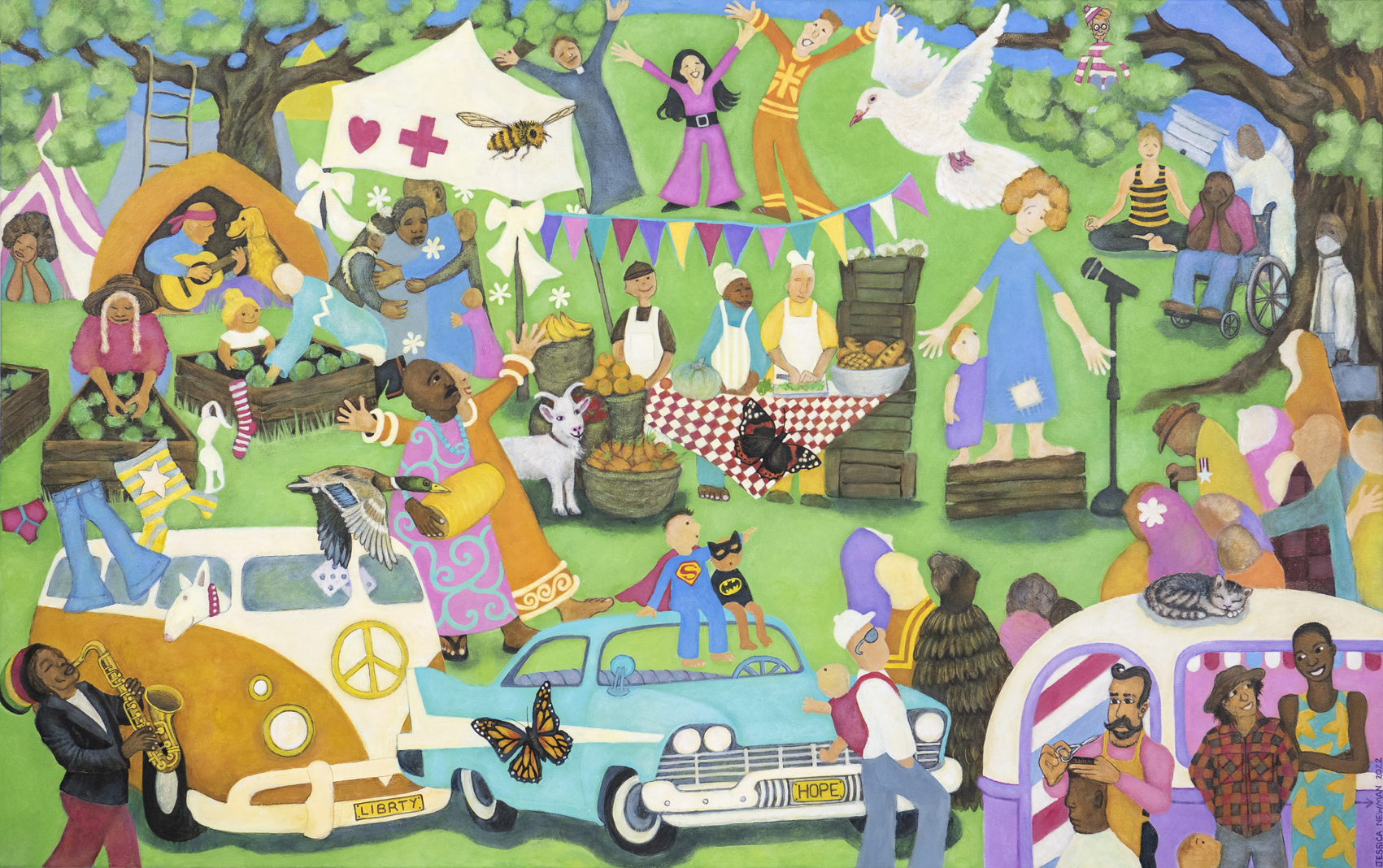
From the top to the bottom
By Jessica.
From the top of the North to the bottom of the South, in our thousands we came.
With our pain and our stories, we came.
Ignored, accused, abused and abandoned by the very Kaitiaki we had chosen to represent us, we came.
We came to be seen. We came to be heard.
But still you ignored us. Still, you overlooked us.
You labelled us ferals, filth and fascists, simply for standing up for our right to choose, our right to say no.
We stood together as a beautiful diverse people of Aotearoa. United with one Kaupapa- Our Freedom.
We shared our stories with one another.
Stories of our lost loved ones, the vaccine injured, lost jobs, lost livelihoods, lost homes, lost relationships.
And we listened to each. And we hugged.
The division, discrimination and injustice imposed upon us, ignited a Kiwi Spirit never experienced before. A Village of compassion and kindness arose. We took care of each other’s needs. We celebrated our Courage and Unity with Peace and Joy.
The River of Filth was actually A River of Love.
If you watch Main Stream Media (MSM) news you wouldn’t have seen this.
This was not what the government wanted you to see.
The NZ Media Council exists to set standards of’ Accuracy, Fairness and Balance’ in reporting, but recent research shows that less than half of us trust the news in general.
How much do you trust the media?
Alarmist headlines, biased journalism coverage, and recent government funded media ‘support’ are raising questions amongst us.
Does MSM appear to be pushing the government’s narrative and agenda?
You decide.
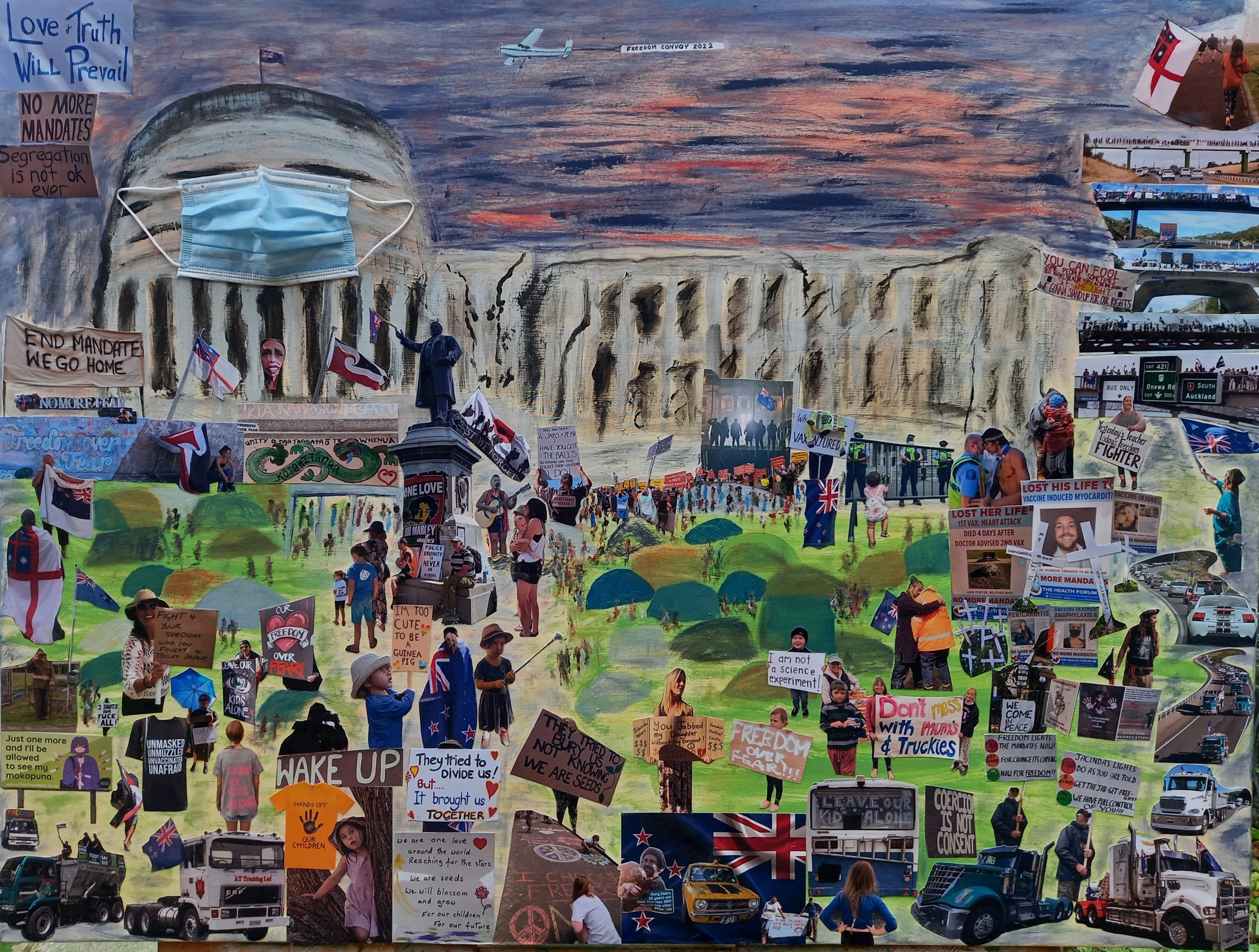
Parliament Lawns
By Kate.
Freedom village, a wonderful place where we met so many beautiful people with big smiles, real eye contact and we learned of many sad stories. We found unity, love and a strong vibrant connection. And after the first week or so, while Tony continued to train into Welly with his gold card, I started working on my new art project, a mixed media artwork comprising of photos and wonderful memories of this special time and place in our history.
On Wednesday 2nd March I got the big O. With zero energy, I stayed in bed and slept amidst the angst, knowing the horror, feeling the beautiful loving energy being ripped apart less than an hour away from our small piece of rural paradise. Since then I’ve really struggled to come back. I consider myself a strong person, nothing much fazes me – ever. But this did. It broke my heart. What’s the point, what next, where to from here? And there were no answers.
Just my thoughts at this point in time.
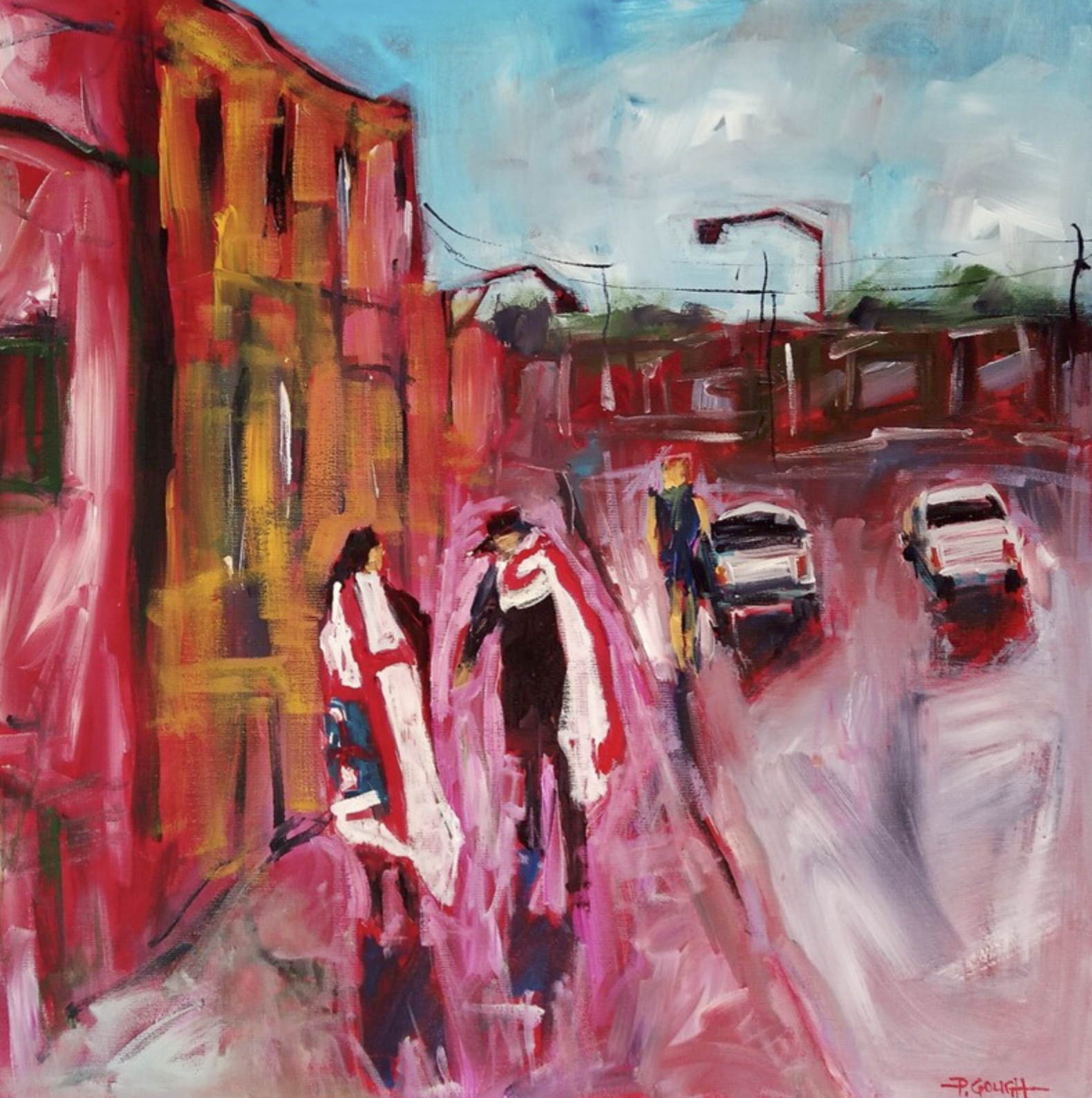
The Road Less Travelled
By Pauline.
Help fund independent voices in New Zealand.
Unlike the mainstream media in New Zealand, the filmmakers of We Came Here For Freedom do not receive any funding, from government or otherwise.
However, we do believe the film’s message of freedom of speech, freedom of choice and democracy is an important one, so we have made this film free to view so as many people as possible are able to see it. Therefore, if you believe in the importance of free speech as much as we do, please consider donating to help us continue our work.
